How to nail that presentation
- Business Skills
- Presentation Skills
Presentations - types and structures

This is a standalone lesson but it can also be used as part of the set titled:
- Delivering presentations

LESSON OVERVIEW
In this lesson about business presentations in English, students discuss presentation structures in depth, watch a video with tips on giving presentations , and learn useful words and phrases related to the topic.
The lesson is the first of the three-part series of lessons about delivering presentations. You will find the second part of the series here and the third part of the series here .
VOCABULARY & VIDEO
The lesson starts with a matching exercise in which students learn some common collocations (e.g. step up your game, nooks and crannies ). After that, students use the collocations to complete six statements referring to business presentations (e.g. joking during a presentation, using visual aids). Then, students discuss if they agree with the statements or not. Before watching the video about virtual presentations, students decide whether the tips listed in the task should be on the ‘do’ or ‘don’t’ list . They watch the video and check their answers. During the second viewing, students have to answer a few comprehension questions about the video. This task is followed by a short discussion during which students share their opinions on what they learned from the video.
TYPES & STRUCTURES OF BUSINESS PRESENTATIONS
This part of the lesson starts with a vocabulary exercise . Students read a short text explaining what an elevator pitch is, and find words (e.g. affable, detract from ) which match the given meanings. Then, they briefly discuss the idea of an elevator pitch and other types of business presentations. After that, students match descriptions to four types of presentations (e.g. annual stakeholder report, team briefing ). In the last part of the lesson, students do a speaking activity in which they talk about structures of different kinds of presentations (e.g. pitching an app to investors, giving a demo for the MVP ). They also brainstorm possible challenges each of them presents, and discuss what tips they would give to a person delivering the presentation.
Subscribe to unlock these and many other Standalone lesson lesson plans with the Unlimited plan
Leave a Reply Cancel reply
You must be logged in to post a comment.
Powerpoint needs correction on page 18-19. Things are not in the right place
Powerpoint needs correction on page 16-17. Things are not in the right place
Cris, are you sure you’re referring to the right slides? Only slide 16 has a ‘moving’ element and slides 17-19 are static. Nevertheless, I checked these slides in Chrome, Safari and Mozilla and everywhere it all renders correctly. Please email us at [email protected] with a screenshot of the misalignment and info what browser you use.
If you’re downloading the e-lessons as Powerpoint slides, you need to ensure you have the correct fonts installed on your computer – otherwise your computer will substitute them for a different one, which may not be the same size, and therefore affect layout.
Most of the ESLBrains Powerpoints seem to use the Signika font. If you Google “Signika font”, you can download it for free. Install the font files on your Mac or PC, and you’re good to go.
wow! Really useful the lesson!
Browse other materials recommended for you

Office, remote or hybrid?
With this up-to-date lesson, students discuss work life after lockdown and practise vocabulary to talk about workplace changes. They also watch a news video about companies changing the way they work and discuss different work models.

As per my last email…
Dive into the intriguing world of emailing and talk about what annoys people the most. With this lesson, students expand their vocabulary, express irritation, and analyze real-life situations.

Is a degree worth it?
Engage your students in a discussion on the ins and outs of higher education. Explore education and career-related vocabulary and work on comprehension skills by watching a news report on the job market.

How to stand out at work
Let your students share opinions on getting promoted and being noticed at work. They will discuss hypothetical situations, share experiences and comment on advice from a video.

All about branding
This is a perfect lesson for students who want to discuss brands and the idea of branding. Students learn and practise useful phrases, as well as improve their comprehension skills.

Talking about leaders
Students talk about good and bad leadership, watch an explainer video and share their experiences. Let them explain why they’d rather be a good leader or have a good leader.

Ready to go paperless?
In this lesson, students learn some vocabulary related to document management, talk about going paperless, watch a video, and work on word building learning suffixes ‘-ful’ and ‘-less’.

Passive income
In this passive income ESL lesson plan, students watch a video, learn vocabulary and have speaking practice.

How to succeed as a freelancer
In this lesson students discuss working as a freelancer. They watch a video, do four role-plays and talk about different freelancing ideas.
Is there a minimum subscription period if I choose a monthly subscription?
No, there’s no minimum required number of subscription months. You can cancel any time you want. Basically, you can sign up and then cancel your subscription the next day, which will mean you have access for 1 month and won’t be charged again.
What currencies can I pay in for my subscription?
Our default currency is USD (American dollar), but you can also pay in EUR (euro), GBP (British pound sterling) or PLN (Polish zloty). You can change the currency you want to pay in at the Pricing page before selecting a subscription plan.
How can I edit an e-lesson plan?
You can get your own editable copy of an e-lesson plan and make changes to it. To do so, either (1) make a copy of it on your Google Drive (preferable method) or (2) download it in a Powerpoint format (but formatting might be a bit off so we can’t guarantee that it will work well).
We are using cookies to give you the best experience on our website, personalize content and analyze website traffic. For these reasons, we may share your site usage data with our social media, and analytics partners. You can find out more about which cookies we are using or switch them off in settings.
Privacy settings
With the slider, you can enable or disable different types of cookies:, this website will:, this website won't:.
- Essential: Remember your cookie permission setting
- Essential: Allow session cookies
- Essential: Gather information you input into a contact forms, newsletter and other forms across all pages
- Essential: Keep track of what subscription you select to buy
- Essential: Authenticate that you are logged into your user account
- Remember your login details
- Functionality: Remember social media settings
- Functionality: Remember selected region and country
- Analytics: Keep track of your visited pages and interaction taken
- Analytics: Keep track about your location and region based on your IP number
- Analytics: Keep track of the time spent on each page
- Analytics: Increase the data quality of the statistics functions
- Advertising: Tailor information and advertising to your interests based on e.g. the content you have visited before. (Currently we do not use targeting or targeting cookies.
- Advertising: Gather personally identifiable information such as name and location
- Advertising: Use information for tailored advertising with third parties
- Advertising: Allow you to connect to social sites
- Advertising: Identify device you are using
- Essential: Keep track of what you input in a shopping cart
- Essential: Remember language version you selected
- Advertising: Allow you to connect to social sitesl Advertising: Identify device you are using
Username or Email Address
Remember Me
Your browser is not supported
Sorry but it looks as if your browser is out of date. To get the best experience using our site we recommend that you upgrade or switch browsers.
Find a solution
- Skip to main content
- Skip to navigation
- Macmillan English
- Onestopenglish
- Digital Shop

- Back to parent navigation item
- Sample material
- Amazing World of Animals
- Amazing World of Food
- Arts and Crafts
- Mathematics
- Transport and Communication
- Teaching Tools
- Sustainable Development and Global Citizenship
- Support for Teaching Children
- Vocabulary & Phonics
- Spelling Bee Games
- Phonics & Sounds
- The Alphabet
- Onestop Phonics: The Alphabet
- Alphabet Booklet
- Interactive Flashcards
- Warmers & Fillers
- Young Learner Games
- Stories and Poems
- Fillers & Pastimes
- Fun Fillers
- Ready for School!
- Topics & Themes
- Young Learner Topics
- Young Learner Festivals
- Festival Worksheets
- Art and Architecture
- Business and Tourism
- Geography and the Environment
- Information Technology
- Science and Nature
- Topic-based Listening Lessons
- Cambridge English
- Cambridge English: Preliminary (PET)
- Cambridge English: First (FCE)
- Cambridge English: Proficiency (CPE)
- Cambridge English: Advanced (CAE)
- General English
- News Lessons
- Topics and Themes
- Beyond (BrE)
- Beyond: Arts and Media
- Beyond: Knowledge
- Go Beyond (AmE)
- Go Beyond: Arts & Media
- Go Beyond: Knowledge
- Impressions
- Macmillan Readers
- A Time to Travel
- Life & School
- Skills for Problem Solving
- Digital Skills for Teens
- Support for Teaching Teenagers
- Games Teaching Materials
- Business and ESP
- Business Lesson Plans
- Business Skills Bank
- Business Top Trumps
- Elementary Business Lessons
- HR Management
- Business News Lessons
- ESP Lesson Plans
- Career Readiness
- Professional Communication Skills
- Cambridge English: Business (BEC)
- Everyday Life
- Celebrations
- Live from...
- Live from London
- Discussion Cards
- Writing Lesson Plans
- Life Skills
- Support for Teaching Adults
- Vocabulary Lesson Plans
- Language for...
- Vocabulary Teaching Materials
- Macmillan Dictionary Blog
- Vocabulary Infographics
- Kahoot! Quizzes
- Blog Articles
- Professional Development
- Lesson Share
- Methodology: Projects and Activities
- Methodology: Tips for Teachers
- Methodology: The World of ELT
- Advancing Learning
- Online Teaching
- More from navigation items
Business Skills Bank: Giving Presentations
By Tim Bowen
This Business skills lesson plan by Tim Bowen presents common features of presentations and practises useful language for putting together and giving presentations.
Lesson length: 60-75 mins
Materials: Worksheets 1-5
Subsidiary aims: Listening (or reading) for specific information, discussion of what makes a good presentation.
Business Skills Bank: Giving presentations—Worksheets
Business skills bank: giving presentations—teacher's notes, presentations part 1, presentations part 2.
- British English
- Business / ESP
- Intermediate
- Lesson Plan / Teacher's Notes
- Pre-Intermediate
- Printable Worksheet
- Up to 90 mins
- Upper-Intermediate
- Whole Class
Related articles

Business Skills Bank: Meetings
Sara Helm introduces a short series of lessons for business professionals on meetings skills and the type of functional language needed to conduct meetings in English.
Business skills bank: Preparing for a first meeting: Part 3
By Sara Helm
In this lesson students participate in a business meeting, while the teacher observes and takes notes for a performance review.
Business skills bank: Preparing for a first meeting: Part 2
A lesson to help review and practise language for leading and participating in meetings.
3 Readers' comments
Only registered users can comment on this article., more from business lesson plans.

Live from London: Business—Negotiations
By Pete Clements
Watch authentic London office workers describe the ways to conduct successful negotiations and the skills good negotiators need. Now Interactive!

Live from London: Business — Dress codes
Watch authentic London office workers giving advice on the best ways to dress to impress. Try the new Interactive Worksheets!

Live from London: Business — Emails
By Bryan Goodman-Stephens
Watch authentic London office workers explain how they use emails and phones to communicate in their companies. Now with Interactive Worksheets!
Join onestopenglish today
With more than 700,000 registered users in over 100 countries around the world, Onestopenglish is the number one resource site for English language teachers, providing access to thousands of resources, including lesson plans, worksheets, audio, video and flashcards.
- Connect with us on Facebook
- Connect with us on Twitter
- Connect with us on Youtube
Onestopenglish is a teacher resource site, part of Macmillan Education, one of the world’s leading publishers of English language teaching materials.
- Privacy Policy
- Cookie policy
- Manage cookies
©Macmillan Education Limited 2023. Company number: 1755588 VAT number: 199440621
Site powered by Webvision Cloud
- Frequently Asked Questions (FAQs)
- Terms and Conditions
- British Council Global
- Accessibility
© 2024 British Council
- Mini English Lessons
- Business English
How to Ace Your Business Presentation in English

So, you need to make a business presentation in English.
First of all, congratulations! To be in your position, you must have invested a huge amount of time and effort in your English language skills. You should be proud.
That said, we totally understand that giving a presentation in a second language can be a challenge. You may be worried that your audience won’t understand your accent. Perhaps you are wondering whether you need to use specific vocabulary. Maybe you’re not sure how best to handle questions from your audience.
If this sounds like you, don’t worry. In this post, we’re going to run through our top tips for acing your business presentation in English. Even if you’ve already made a few presentations in the language, we’re sure you’ll find these suggestions helpful.
So, read on to learn more. And before we start, let us wish you the very best of luck in delivering your next presentation.
Understand your audience
As with all forms of communication, it’s vital that you understand who your audience is. Even in the business world, you can find yourself speaking to very different groups of people.
For example, if you are giving a presentation to members of another company, you would certainly be more formal than when you give a presentation to members of your own team. In each case, you need to think about what your audience will expect from your presentation.
So, before you write a word, ask yourself these questions about your audience. Who are they? What interests them? What do they need to know? What do you want them to do as a result of your presentation?
One useful tip for writing your presentation is to imagine your audience is a single person. It’s easier to write convincingly if you have a single person in mind. Try it!
Mind your language
Most audiences will expect you to give your presentation using formal Business English . Don’t make the mistake of confusing Business English with business jargon .
Successful Business English uses language that is simple, direct, professional and easy to understand. Business jargon on the other hand, relies on obscure phrases, clichés, and acronyms. In many cases, business jargon is complex, not very precise and a barrier to good communication .
We have some useful resources on Business English on this page . However, if in doubt, keep the language of your presentation as simple and clear as possible. It’s also a good idea to use sentences with the active, rather than the passive voice. This allows you to use fewer words, which makes your sentences shorter and more engaging.
To give an example, this is a sentence in the passive voice:
The interview was failed by over one third of applicants.
Now compare this sentence, which is in the active voice.
Over one-third of applicants failed the interview.
To learn more about the active and the passive voice, check out this explainer from the British Council.
Practise, practise, practise
If English isn’t your first language, it’s more important than ever to practise your presentation before delivering it. By practising, you’ll feel more comfortable using English in a business setting. You’ll be able to work on any words or phrases you find difficult to pronounce, or you can change them to words or phrases you are more comfortable with.
Ideally, you should practise giving your presentation in front of someone else. That way you can get useful feedback on what works well, and what doesn’t. If that’s not possible, make a video of yourself giving your presentation. When you see yourself on screen, it will give you helpful insights into ways you can improve your delivery.
Don’t forget to introduce yourself
It may sound obvious, but don’t forget to introduce yourself at the very beginning of your presentation. It not only breaks the ice , but it’s an opportunity to get the audience on your side. If you are presenting to native English speakers, you may wish to tell them that English is not your first language – but don’t apologise for it! If anything, your audience will be impressed that you can give a presentation in a second language.
Have a clear structure
When people learn to teach in the UK, they are often told to structure their lessons in this simple way:
- Say what you’re going to say
- Say what you’ve said
In other words, introduce the session by explaining what you intend to talk about. This sets the audience’s expectations – they know what’s going to happen.
You then use main part of the session to make your presentation. There are many effective ways of doing this, and we’ll cover some of these soon.
Finally, finish by summarising the most important points of your presentation. This helps your audience to remember them clearly.
One other tip, if you plan to let the audience ask questions, it’s a good idea to tell them you’d prefer to answer them at the end of the presentation. This will discourage them from interrupting your presentation at the wrong moment.
Use storytelling
People love stories. If you can capture your audience’s imagination with a story, you can make a very powerful impression.
For example, imagine you are giving a presentation about how to commission new advertisements for your company. You want to make the point that good copywriting as just as important as good visual design.
You can either make your point directly, like this:
“Successful adverts rely on good writing as well as good design. If you change the wording of an advert, it can often result in extra sales – or fewer. Therefore, the words we choose are as important as the images we use.”.
Or you could begin with a story, like this:
“I want you to imagine it’s the year 1907. A man called Louis Victor Eytinge is in prison, convicted of murder. He’s a drug addict, suffering from tuberculosis. He’s unlikely to live, never mind get out of jail. Yet, by 1923 he walked free into a well-paid advertising job and a career as a Hollywood screenwriter. How? He had written his way to freedom. I want to use his story to show you why, if we want successful adverts, we need to commission powerful writing as well as good design.”
Which version of the presentation would you rather listen to?!
Remember pace and pitch
One useful tip for acing your business presentations in English is to vary the pace and pitch of your delivery.
While you don’t want to speak too fast, it’s a good idea to use a different pace for different parts of your presentation. For example, when you want to communicate a key point, speaking more slowly will help people understand that you think it is important.
Equally, it’s a good idea to vary the pitch of your voice. Try and keep this as natural as possible, but experiment with using a higher pitch when asking questions and a lower pitch when beginning your sentences. One good way to learn how to vary your pitch is to listen to UK news broadcasts – news presenters are expert at varying the tone of their voice to keep listeners interested.
Add a call to action
Most business presentations are given for a specific purpose. You may want to convince another company to work with you. Or you may want to convince your own firm to invest in a new kind of product. You may simply be explaining to colleagues how a new training scheme will work.
Whatever the purpose of your presentation, always remember to tell your audience what you want them to do. This is a ‘call to action’. Do you want your audience to email you their ideas? Or send you a funding proposal? Or arrange a meeting?
No matter what you need your audience to do, don’t forget to tell them. And at the very end, be sure to thank them for their time!
More business presentation tips
There are many other tips we could share with you on how to ace a business presentation in English. For example, it’s never a good idea to read your presentation from a piece of paper – it’s not engaging and it means you can’t easily make eye contact. It’s also tempting to rely too heavily on visual aids like PowerPoint, but if you get it wrong your audience will read your slides instead of listening to you. On the other hand, it can really engage an audience if you ask them to work together in small groups to share ideas or solve problems.
However you choose to make your presentation, if you prepare well, speak clearly and work hard to connect with your audience, you are very likely to succeed. And if you’d like to improve your presentation skills even further, why not try live online classes with English Online ? They can help you succeed in any career where using English is essential.
Leave a comment Cancel reply
Your email address will not be published. Required fields are marked *
Related Posts

Conquer Communication: Overcoming passive-aggressive behaviour at work
Have you ever been in a meeting where a sarcastic “Sure…” throws the whole atmosphere off balance? Welcome to the world of passive-aggressive behaviour […]

Effective Communication 101: How to Not Sound Passive-Aggressive in Your Writing
Learning English can be challenging enough, but encountering a passive-aggressive tone can add an extra layer of difficulty for learners. If you have ever […]

Emoji Etiquette: How (and When) to Use Emojis at Work
In recent years, emojis have moved from personal chats into business communications, adding some extra personality to workplace messages. As the lines start to […]
Get Exclusive access to offers and promotions
Enter your email address below to join the english online mailing list..
Personal details will be held by the British Council and will only be used in relation to your request. Please read our terms of use for more information.

Business English Lesson plan- Giving a Presentation (ESA Framework)

Type of Lesson: Integrated skills (Listening integrated to speaking, pronunciation and vocabulary using authentic material. Theme: giving presentations)
Aims: To identify the characteristics of a good and bad presentation To introduce vocabulary related to presentations To review sentence stress and intonation patterns for effective presentations.
Outcome: By the end of the lesson, students will be able to give a sales presentation about their companies’ new product.
Read: 5 Great Activities to Use with Your Business English Students!
Read: How to Conduct a Needs Analysis for Your Business English Class
Assumptions: Students have a wide range of vocabulary related to the business field. They are able to articulate full sentences using complex and compound sentences. They are aware of how important intonation is when delivering a message. They are able to differentiate intonation patterns. They will already know many adjectives that are used to describe the product they sell at their company, as they will have used them in their own language while performing sales pitches. They have prior experience in giving presentations in their own language and have given presentations in previous ESL classes. They are familiar with the structure of a presentation: introduction, overview, state points, state results and conclusions, summarize, and close.
– Save $100 with the TESOL Diploma and Teaching Business English Specialist Package! –
Students background information: Students are to give a sales presentation about their companies’ new product at a business conference. They are well established sales people in Japan and this will be their first time presenting their product in an overseas environment.
Anticipated Problems and Solutions: Students may not be able to recall some ‘great speakers’. In this case, the teacher will suggest people such as Martin Luther King Jr., Steve Jobs, etc. They may have difficulty using proper intonation in certain phrases; this will be solved by demonstration and drilling. They may also have problems with some pronunciation in the intonation exercise. The teacher will be around to assist students with their individual needs.
Aids/Materials: YouTube video “Enhancing Your Presentation Skills”; a vocabulary presentation worksheet; stress and intonation worksheet; Steve Jobs iphone 2007 presentation YouTube Time: approx. 150 minutes
ENGAGE – Business English Lesson Plan
– Learn to create Business English lesson plans online! –
Aim: to introduce the topic of giving presentations and to outline skills and characteristics that lead to a good presentation. Techniques used: questionnaire; discussion; brainstorming Skills: speaking and listening Interactive Pattern: SS Time: 10 minutes
Aids/Materials: handouts with questions/board
Put students into pairs and have them discuss the following questions:
1. What are the characteristics of a great speech/presentation? 2. Who are the greatest speakers that you can think of? 3. Who do you need to give presentations to as a part of your job? What are they about?
Once students have finished discussing in pairs, have an entire class feedback and have students brainstorm the characteristics of a great speech are. (Examples of ideas that will be elicited: eye contact, clear voice, positive body language, etc.).
STUDY – Business English Lesson Plan
20-hour Teaching Business English Course Only $199!
Step 1: introduce words and phrases related to giving presentations Techniques: Gap-filling Skills: Reading and speaking Interactive Patterns: T-S; SS Time: 5-10 minutes
Aids/Materials: Vocabulary: Presentation Language worksheet.
Students will be given a ‘Vocabulary: Presentation Language’ worksheet that uses words and phrases suitable for presentations. They are to work in pairs in order to fill in the blanks of the passage. After students have completed this activity, the teacher will take it up as a whole class and discuss any vocabulary words they were unsure of.
Vocabulary: Presentation Language
Complete the following presentation excerpts using the words below.
after that finally illustrate outline to start with then describe specifically purpose sum up thank tell you
Good morning, everybody. I hope you are all doing well today and I’d like to _______ you all for being here. Today I am here to __________ about our latest product, and more _________ about how it works and what it does. I’d also like to __________ the products’ features and __________ inform you about where you can get it and how. ____________, I’d like to briefly __________ our current marketing policy in Canada. ________, I’ll __________ some of the problems we have encountered in our market share. ___________, I’ll ________ our progress this year and continue on with our main _______ for being here; the product.
Answer Key: thank, tell you, specifically, illustrate, finally, to start with, describe, then, outline, after that, sum up, purpose
Step 2: To identify how important intonation is in delivering a sound presentation Techniques: Elicitation Skills: Listening and speaking Interactive Patterns: T-S Time: 5 minutes Aids/Materials: Vocabulary: Presentation Language worksheet
The teacher will read the excerpt twice. T will ask the students to listen carefully and identify the differences. The first time, T will read it using proper sentence stress (stressing content words: nouns, main verbs, adjectives, adverbs), intonation and tone of voice. The second time, T will read it in a monotone voice. Then T will elicit the difference and which one is more effective and why: T: “Which speech was more effective?” S: “The first one” T: “Why?” S: (Possible answers) “You used expression, your voice changed, you sounded enthusiastic. In the second reading, your sounded dull, boring.”
Read: How to Use the Communicative Approach
Read: How to Use Task-based Learning
ACTIVATE – Business English Lesson Plan
Aim: Practice intonation patterns Techniques: reading aloud Skills: speaking and pronunciation Interactive Patterns: SS Time: 10 minutes
Aids/Materials: “Good and Bad Stress and Intonation” from UsingEnglish.com
The teacher will hand out the worksheet “Good and Bad Stress and Intonation”. Students will work in partners to practice saying the sixteen sentences with both good and bad intonation. The back of the worksheet provides helpful tips in how to express the sentences in the best and worst ways possible. Once students have finished practicing with a partner, they will go over each sentence as a whole class. The teacher will correct them where necessary
Step 1: Aim: to identify characteristics of effective presentations. Technique: note-taking, listen for main ideas Skills: listening and speaking Interactive patterns: S and SS Time: 10-15 minutes Aids/Materials: YouTube video “Enhancing Your Presentation Skills- Killer Presentations” by Doug Jeffries. (about 7:18 minutes)
The teacher will play the video twice to ensure students have a full understanding of the content. Students are responsible for noting at least five presentation skills that Doug Jeffries mentions in the video (Making your audience comfortable, establishing eye contact, ‘power of the pause’, body language/gestures, effective content). They will then go over and discuss the importance of each point as a whole class. For example:
T: “Why is establishing eye contact important when giving a presentation?” S: “It engages the viewer and allows them to know that you are speaking directly to them”
The teacher will now ask students if they know who Steve Jobs was and what he was responsible for.
T will tell the students that they will now watch a presentation by Steve Jobs and they have to discuss the following questions:
– Can you identify any of the presentation skills described by Doug Jeffries in Steve Jobs’ video?
– What makes Steve Jobs’ iphone 2007 launch presentation effective? (Possible answers: visuals, timing of speech accompanied by visuals, clear voice, confidence, knowledge of product).
– How does he keep the audience engaged? (Possible answers: movement, gestures, tone/pitch, humour, repetition (“re-invent, revolutionary”)
T will ask students to take a closer look at Steve Jobs’ presentation. T will direct them to identify any words they think made his presentation effective; words he repeated, words that they think helped to describe/promote his product. Students should pick out certain adjectives such as revolutionary, life-changing, re-invent, magic, etc. T will write students’ answers on the board and then ask them to think of other vocabulary words they could use to sell a product, focusing on a product that the company they work for sells. “If you were to sell your company’s new product in a presentation like Steve Jobs’, what type of words would you use to engage the audience and make them want to buy your product? Come up with as many adjectives as you can to promote your product.” Students will compile an individual list. Once they have finished their lists, they will discuss their adjectives together as a class. T will write their ideas on the board, adding to the list that we compiled from Steve Jobs’ presentation and give the students time to copy any of the adjectives that they wish to use for their presentations into their notes.
Aim: Students will create a presentation with the assistance of ICT tools (PowerPoint/Camtasia) to sell a product to their classmates using appropriate vocabulary and body language. Techniques: collaborative writing and discussion Skills: Speaking, listening, reading and writing Aids/Materials: computers with Camtasia program and Microsoft PowerPoint Interactive Pattern: SSS Time: approx. 50 min.
For the final stage of the lesson, T will tell students that they are going to create a presentation, much like the one they viewed in the Steve Jobs video, using ICT tools (Camtasia or Powerpoint) to sell a product of their choice. The product must be something they are fully aware of as they will not have much time to research.
T will briefly go over the main stages of a presentation. Students’ presentation must follow this format: introduction, overview, state point, state results, summarize, and close.
Other points to remember to use in their presentations are: -use of vocabulary (adjectives and phrases) to describe the product -body language, gestures and intonation -synchronization of their speech with the slideshow presentation
After each student presents, the rest of the class will give them feedback regarding their presentation (both good and bad) and what they need to work on for a real life sales presentation scenario.
Adapted from lesson plan by 120-hour TEFL certificate graduate.
Take a TESOL course with Teaching Business English specialist!
Leave a Comment
Your email address will not be published. Required fields are marked *
This site uses Akismet to reduce spam. Learn how your comment data is processed .

How to Prepare an Impactful Business Presentation in 8 Steps
/ Steven Hobson / Business English , Confidence , English Presentations , Speaking

For non-native speakers, giving a business presentation in English can be a scary experience, especially if you don’t do it often or feel insecure about speaking English in front of others.
Over the years, I have helped a range of professionals prepare for business presentations, as well as training teachers to prepare their students for presentations when I ran my own language school in Brazil.
During this time I constructed a very effective approach that can be used if you are preparing for a business presentation but do not have a coach or trainer t o guide you.
In this post, I’m going to share with you this proven approach which consists of 8 steps.
Step 1: The Foundation to Your Business Presentation – Goal, Audience, Past Experience
This first step is essential for a successful business presentation, as it sets the foundation for the rest of your preparation.
Ask yourself what exactly it is that you want to achieve with this presentation. In other words, what is the goal? What do you want to communicate and how do you want the audience to react or take action?
In addition to this, consider your audience. How many people will you be presenting to? Do you know the audience personally or are they unknown to you? What will they be expecting? Are there any cultural differences you need to be aware of? For what reasons are they listening to your business presentation?
lastly, if you have given business presentations in English before, reflect on your experience. What were your main challenges and how will you face them this time around? What improvements do you need to make?
I prepared an executive who once told me that he froze up when he was stopped to ask questions during his presentations. He was worried about whether he was going to understand the questions correctly, as well as being capable of giving a good answer under pressure.
For this, we worked on how to ask for clarification if he wanted to make sure he understood the questions, and then we wrote down all the possible questions he could get asked and rehearsed the answers.
This reflection and extra preparation helped the executive to overcome his nerves and anxiety for his next business presentation.

Step 2: Prepare the Slides with Minimum Text
One of the biggest mistakes I see people making when putting their slides together is including too much text. Or even worse, their speech is the text which is written on the slides.
If there is too much text, three damaging things can happen.
First, the presenter spends more time reading the slides and doesn’t look at the audience enough. This makes it difficult to establish a connection with your audience.
Secondly, good eye contact can communicate confidence and authority , which helps the audience to agree with or believe your message. Therefore, spending too much time looking at the slides can affect how confident or authoritative you look, which will consequently weaken your message.
Thirdly, it confuses your audience because they don’t know whether to read the slides or listen to you. Both, they cannot do. And potentially they could miss important parts, let alone diminish engagement.
So ask yourself these questions when preparing your slides: Is there too much text? Could the slides be better summarized? Could there be more images?
The slides should really be as condensed as possible using keywords , as well as being visual.
Step 3: Record Yourself from Beginning to End
Before writing down your speech or doing any rehearsals, record yourself (audio or video) giving the business presentation from beginning to end.
Your presentation will be unpolished and rough, however, this exercise will give you some immediate and useful insights on how you present and what you need to improve.
When playing back the recording try to look out for the following:
- the parts of the presentation you are finding difficult to explain,
- if you are being objective enough or taking too long to explain something,
- how often you use filler word s, such as “erm”, “um”,
- whether you are using a variety of linking phrases between parts,
- if there are any grammar mistakes you can recognise.
These insights will help when you start working on your speech, which is the next step.
Furthermore, you can compare this initial recording with future recordings. This will help you perceive your progress, which will build confidence.
Step 4: The Introduction
Next, you’re going to focus on the separate parts of the business presentation, beginning with the introduction.
The introduction normally includes a few sentences to welcome the audience, say a little bit about who you are, communicate the objective of the business presentation, and then give an outline of the main parts of the presentation.
I recommend writing down the script and memorizing the introduction word for word, as it is only going to be a few sentences. You can write it in the ‘notes’ section at the bottom of the PowerPoint slides.
Memorizing the introduction will strengthen the delivery of it, and a strong intro will not only calm down your nerves , it will also give the audience a great first impression of you which helps to build trus t .
Practice out loud a few times then move on to the middle section.
Click here for introduction phrases for a business presentation.

Step 5: The Middle
Just like the introduction, write down the script for the middle part. However this time, the reason for writing the middle section is to make your speech more objective and straight to the point, rather than memorizing it word for word.
I suggest working through your business presentation part by part. Write the script for a specific section, practice saying it aloud a few times, then move on to the next part.
An important part of the middle section is how you link all the different parts and slides together. Make sure you use a variety of linking phrases to join everything up and maximize presentation flow.
Here’s an example of a linking phrase: “Ok, I’ve explained how ABC works. Now I’d like to change direction and talk about XYZ.”
Linking phrases help you move through the business presentation smoothly and the audience will be able to follow it easier.
Once you have written your speech, a useful exercise is to run through the presentation only saying the linking phrases. This will help you identify if you are using enough variety and it will cement the structure of the presentation in your mind.
Click here for more linking phrases for the middle section of a business presentation.
Step 6: The End
For the ending, use the same method as the introduction and middle section – writing the speech and then practicing it orally.
Just like the intro, the ending is normally quite short and consists of a summary or conclusion, followed by questions, then thanking the audience.
Click here for expressions to help you with the ending of a business presentation.
Step 7: Practice and Repeat from Top to Bottom
Practice and repetition is the most important aspect of preparing for a business presentation.
By now, you have edited your slides, written your speech, and practiced each section individually a few times. You have also chosen a variety of linking phrases to improve the flow of the presentation.
At this point, you need to practice the presentation aloud as many times as you can from beginning to end. I suggest that you record yourself every now and again, listen to the playback and note down where you think you can improve.
Go back to that very first recording and compare yourself now. Your progress will be visible and this will increase confidence. As you continue to practice, you’ll find that your fluency level will improve.
If possible, practice in front of work colleagues and ask them to give you feedback. This will give you experience presenting in front of people, and there’s always something which we miss while other people notice.
Alternatively, look for a coach or trainer to help you. I offer this service online. Apply for a free evaluation here.
Step 8: Anticipate Audience Questions
When you are feeling comfortable giving the presentation, the next step is to anticipate questions that your audience might ask. Write down how you would like to answer these questions and practice them orally.
You will either invite the audience to ask questions after you have finished the business presentation or in some cases, the audience will interrupt you during the presentation.
It is more challenging when you get interrupted because it breaks the flow. An effective way to prepare for this is to get somebody to ask you anticipated questions during specific slides as you are practicing the presentation. This will help you get used to being interrupted, answering the question, then resuming the presentation again.
Conclusion
By following this 8 step approach, you will find that your confidence and fluency will improve significantly at giving business presentations.
The crucial part is the practice. You can never practice too much.
Be disciplined enough to define a practice routine and follow through with it. When you feel comfortable, practice a few more times. You’ll see that it is worth the effort after receiving praise for delivering a successful business presentation.

Was this article helpful for you? Share this on social media below.
Tags business English business presentations confidence English presentations English speaking ESL Learn English speak confidently
Author: Steven Hobson
Steven is a business English coach, a certified life coach, writer, and entrepreneur. He helps international professionals build confidence and improve fluency speaking English in a business environment.
Related posts

2 Success Principles for Achieving Your English Goals

How to Improve Your Understanding of Native Speakers

LESSON PLAN FOR ENGLISH TEACHERS
Understanding presentations.

Level: Pre-intermediate (A2-B1)
Type of English: Business English
Tags: business people marketing management challenges business skills giving a presentation 16-18 years old 18+ years old Situation based Article based
Publication date: 10/26/2022
This lesson looks at the language of talking about graphs and charts in presentations. Students will read a presentation speech and listen to a presentation while completing a graph. Exercises focus on reading and listening skills, related vocabulary and offer the opportunity for students to discuss questions on the topic.
by Joe Wilson
Understanding_presentations_1_be.mp3
ANA CAROLINA
Really good, I loved the fact it has a lot of takilng points.
Leave a Comment
Student worksheet
Teacher lesson plan
Download audio
Save lesson to
Understanding_presentations_1_ae.mp3
COURSE PLANS
This comprehensive course plan covers the full range of language needs – listening, role play, vocabulary development.
Worksheets in English for Business course plan
Type of English: Business English Level: Pre-intermediate (A2-B1)
Make your lessons unforgettable
Did you know that your students can review the target language from our worksheets with our Expemo flashcard app? To let your student know, just enter their email address below (multiple emails can be separated with a comma).
20+ Great Business English Topics and Lesson Activities
For Business English students, it’s important that ESL lessons are based on the needs of their day-to-day work.
They want to practice situations taken from their professional environment, and discuss real-life Business English topics.
Some are: making phone calls, being able to hold and carry on conversations, speaking with colleagues, preparing and giving presentations, or negotiations.
Join our mailing list to receive a free ESL teaching resource every week.
Click to Join
Coming up with creative activities and finding good topics for your lessons can be tough and time-consuming.
The Business English activities in this post will save you time and effort in making quality content for your lessons.
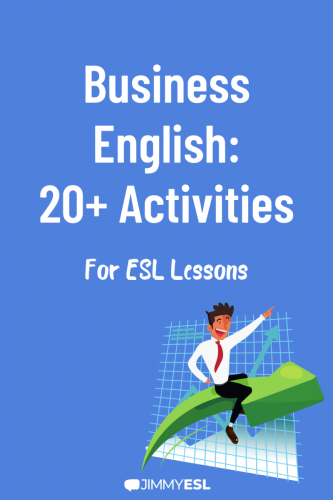
About the Business English Topics And Activities
Topic: airbnb business travel, topic: commuting to work, topic: big business (amazon, coca-cola, netflix, etc.), topic: artificial intelligence and future technology, topic: music, bonus activity.
Lessons including well-designed activities will prepare your students for their professional lives and give them the necessary skills and vocabulary needed to communicate effectively in English.
The 20 activity suggestions you’ll find in this post relate to the topics of business travel, commuting to work, big business, artificial intelligence, technology, and music.
The activities you can do on these business English topics are from specific lesson plans based on videos , which come equipped with a range of different printable Business English worksheets , conversation topics, speaking exercises, listening activities, and writing exercises for adults.
Below are some examples of activities from these lessons that can help your Business English students improve their communication skills.
Airbnb has been expanding their services to open up the market for business travelers.
They are simplifying the process of booking and launched some tools which automatically organize your business trip expenses. This new business travel program is coming out strong.
- Phone Calling
- Writing Accommodation Descriptions
- Leaving Reviews
- Mobile App Concepts
- Debate With Hotel Owner
- Comparing and Contrasting
This topic works especially great with Business English lessons in the real estate, hospitality, or mobile app industries, but also in general for any businessmen or women who have to travel for their jobs.
This is an especially engaging Business English topic for a few reasons: it’s controversial (hotel owners aren’t happy about AirBnB) and it’s a hot topic (more and more people are choosing Airbnb over hotels).
Airbnb is a relatively new global powerhouse, revolutionizing the hospitality industry the same way that Uber revolutionized the taxi industry.
Activity: Phone Calling
Put students in pairs or a group. Assign each student a different role from the roles below, or they can choose one.
Students have to imagine that they are Airbnb hosts who just hosted:
- A small group of middle-aged business travelers
- A small group of young adult party travelers
- A small family of 4 with young children
- An individual traveler who came with his dog
Students then ‘call’ their ‘friends’ (another student in the class) to either leave a voicemail or talk about the experience (or complain about the experience!).
They should describe how the experience was as the host for these types of travelers:
- What was different about hosting each of their stays?
- Was it positive or negative and why?
- Did anything good, bad, surprising, or unusual happen during their stay?
You could even have them imagine what could be a positive and negative experience for hosting these types of travelers.
You could even get a bit more creative with this one by assigning a pair of students a role from the list above, and they have to call the ‘host’ (their partner) and ask them questions or make special requests about their stay, e.g:
- Am I allowed to bring my dog to your property?
- Is there a nice cafe in the area where I can bring my laptop to do work?
- We have a baby who cries a lot during the night. Will this bother you?
Even though with Airbnb, you would probably just message the host online, but in this case, you can make it a phone call to practice speaking.
Activity: Writing Accommodation or Property Descriptions & Reviews
Students work with a partner or group and imagine they are Airbnb hosts offering a special, exotic, or unique type of accommodation rental.
They should discuss and agree on the type of home rental they have to offer, where in the world it is, and create their own online listing for this rental on Airbnb.
In the listing, they should explain what type of rental it is, the location, the check-in and check-out procedure, a description and special features of the accommodation, and other housing details and rules.
Make students offer something different or special about their property – something they wouldn’t get somewhere else. Remember, they want to sell the experience!
Students then present their accommodation profile description to the other students in the class and then give their listing to another student or group.
The other student or group then makes a detailed review for that listing, imagining they actually stayed there.
Activity: Creating Mobile App Concepts in the Sharing Economy
Put students in pairs and give them a list of other mobile apps in the sharing economy.
- Neighborgoods
Based on the name of the app, students have to discuss and explain what they imagine the concept of the app to be and how it works.
After students work together for a couple of minutes, go around the class and ask them to report their answers. If they’re not able to imagine what it might be, you can just tell them.
Ask them questions like:
- Would this type of app be useful for you? Why or why not?
- Which app from this list would help you the most?
Try to create an in-depth class discussion about all of these apps.
For the apps listed above specifically, you can discuss things like:
- If parking is a problem for your students (JustPark)
- What they do with their dog when they go on a trip (DogVacay)
- If they would be interested to drive with a stranger for many hours (BlaBla Car)
- If they’ve ever eaten at someone’s home, from another country or culture (HomeDine)
Then, students can either work with the same or different partners to create their own concept for a mobile app in the sharing economy.
They should focus on things like:
- The special features of the app
- What problem it solves / Why it’s a good idea
- How it works
- What problems could happen when people use your app
An alternative to this one is I’ve also had students imagine that they were the founders of Airbnb, and they have to come up with their own detailed story behind the establishment of the company, which turned out to be a fun activity.
Activity: Debate Between AirBnB Representative and Hotel Owner
Put students in pairs or two small groups and they prepare for a debate.
One student or group takes the position of an AirBnB company representative and the other takes the position of a Hotel Owner.
Each side must prepare, defend, and present their positions to the other groups, presenting information about…
- Why they believe their accommodation service is better (at least 3 advantages of your service) Students must talk about the top reasons to stay in a hotel over Airbnb, or vice versa.
- If you think Airbnb should be legal or illegal and why (obviously the AirBnB rep will say it should be legal and the hotel owner will say it should be illegal)
- The positive impact your service has on society and the economy
- What actual people and guests have said about your accommodation services
You can refer to this article to help students talk about Airbnb versus hotels if they are having trouble coming up with ideas.
Your role as the teacher will be the moderator during the debate – generating follow-up questions for the students or groups when they present their sides. Keep the debate clean and flowing smoothly.
Activity: Comparing and Contrasting (Hotels vs. AirBnB or Uber vs. Taxi)
If for any reason you don’t want to make this an official ‘debate,’ another thing you could do is just make it a general, in-depth class discussion, conversation, or compare & contrast about the advantages and disadvantages of staying in Airbnb in comparison with hotels.
Make sure students talk about their own experiences.
Transition the discussion to the conflict between Uber and Taxi, because they are facing a similar conflict for similar reasons.
If your students enjoyed the discussion about AirBnB and hotels, an interesting follow-up lesson topic for you might be about a businessman who is building hotels designed for outer space .
Many businessmen and women in the modern world have to commute for hours and hours per week to their jobs or for work purposes. Sitting in the car or public transit like this can really have a negative impact on one’s overall lifestyle.
- Telling a Story
- Commenting on YouTube
- Expressing Frustrations or Complaining
- Talking About Lifestyle & Daily Routines
The reason this topic works so well in Business ESL lessons is that it reaches such a wide spectrum of people.
Everyone who has a job as an employee in a company, a school, a factory, etc has a unique situation. All Business English students usually have a lot to say about their experience commuting (or home office if they have that privilege!).
Activity: Telling a Story
Students work in pairs.
Student A: This student imagines that he/she spends a lot of time commuting and is very pessimistic about the situation.
This student believes that they have the worst commute in the world. Describe the situation in detail. The student should complain about it as much as possible and why they hate it so much.
They should take notes on:
- Where you live
- Your daily routine
- Where you go to work
- What’s so bad about the commute / What are the conditions of the commute
- How commuting makes you feel
The student then has to tell one negative story that they have had during their commute.
Student B: This student imagines that they spend a lot of time commuting but is very optimistic about the situation.
This student loves the situation that they have. They should discuss and explain in detail why they have the best commute in the world, talk about it as much as possible and why they enjoy it.
Also, they take notes on:
They tell one positive story that they’ve had during your commute.
After the students write notes for their roles (give them a few minutes), have them describe their situations to their partner.
They should listen to their partner’s situation carefully because they should then report the details of their partner’s situation back to the class!
Activity: Commenting on YouTube
At the beginning of the video, the reporter complains about her long daily routine and commute, and then she says to the audience:
“Before you go and post that comment telling me to ‘move closer’, you need to see that I’m not the only person doing this.”
In pairs, students should come up with a response that the following type of people would write or say to the reporter in the YouTube comments section, e.g:
- What could be a rude response to that statement in the comment section of the video?
- What could be an empathetic response to that statement in the comment section of the video?
- What could be a funny response to that statement in the comment section of the video?
Another activity you could do is give students some imaginary comments to that video, and then the students have to write responses to these imaginary comments. You can make it a speaking or writing activity.
For example, here are a few possible comments to that video:
Comment #1:
“Americans are completely crazy and lazy. You drive these huge cars to work and in reality , you don’t need to. Look at the Netherlands and Denmark – they have very efficient bicycle transport systems and bicycles are much more environmental. It’s stupid to drive everywhere.”
Comment #2:
“The best solution to this problem is self-driving cars. Our tax money should go more to support the production of self-driving cars. That way when people commute they can do productive things. The solution to public transit is getting better wifi connections on the subways and buses.”
You can instruct one student to write a response which agrees with each comment, and the other student to write a response which disagrees with each comment, something along those lines.
Activity: Expressing Frustrations & Complaining
Put students in pairs, or in two groups. You’ll distribute to each student pair or group two cards which read:
- A: Riding on public transport
- B: Driving in a car
Students must work together to come up with a list of all the things that frustrate them, annoy them, stress them out, or make them angry while (1) riding on public transport and (2) driving a car.
The group which comes up with the most things in the time limit (3 minutes should be good) wins.
This activity usually works really well because everyone gets angry, stressed, frustrated, etc. at some point while driving a car or riding public transportation.
A lot of good vocabulary can also come out of this one. You can even teach a couple of fun phrasal verbs related to driving when you talk about this topic:
- Cut (someone) off – “I hate when I’m driving and someone cuts me off and then I have to slam on my brakes.”
- Pull (someone) over – “I hate when I’m driving only a little bit above the speed limit and a police officer pulls me over.”
- Freak out – “I hate driving with my father. He always drives aggressively and freaks out about small things.”
- Run over – “I hate when I run over a nail or a sharp object and my tire goes flat.”
- Hold (someone) up – “I hate when traffic holds me up and makes me late for work.”
You can use this activity for teaching students other terminology that is useful for expressing complaints or frustrations:
- I get frustrated when…
- I get all stressed out when…
- It gets me so worked up when…
- It pisses me off when…
- I totally freak out when…
- I lose my mind when…
- It drives me nuts when…
Have students then use these expressions to talk about their frustrations commuting or about their job in general.
Activity: Talking About Lifestyle, Commuting, and Employment Situations
Spending hours commuting and then hours at the office has become so integrated into the modern working world that it can have quite a profound impact on our quality of life and lifestyle, which is why it’s good to talk about in a language lesson.
Here’s an activity you can do that will give your students a good opportunity to talk about their lifestyle, commute, and employment situation.
It’s also simple, easy to prepare, and generates quality conversation.
Print a number of statements on cards and give them to the students or write them on the whiteboard in class.
Put students in pairs or groups. Have them discuss if they think the following statements are generally true or false and why:
- People are generally happier if they travel to work by car instead of public transportation.
- In the USA, people generally commute to work or school by train or bus.
- 10 days of paid vacation per year is fair from an employer.
- Regular exercise helps people deal with stress from work.
- People are more productive if they have a 4-day working week instead of 5.
Put students in pairs or groups. Have them discuss if the following statements are true or false for them personally and have them explain why:
- There is a positive working atmosphere at my job.
- I am satisfied with my work-life balance.
- Every day I eat a balanced and healthy breakfast before work.
- When I commute to work I try to be productive on the way.
- I prefer working from home rather than going to an office.
- I spend too much time at work socializing with my colleagues.
Speaking about daily routines is also a great activity if you’d like to focus on the present simple as a grammar point for your lesson.
Using big companies and corporations as a topic in your Business English lessons is practical for obvious reasons and you can make it fun too for your students.
It’s especially great to use big business as a topic if you actually have adult students who work in big companies, but they’re also applicable topics for students who have their own business or who work in smaller companies.
- History & Fun Facts
- Developing a Product
- Making Slogans
- Analyzing the Impact of Technology on Jobs
Activity: History & Fun Facts About Big Companies
As a lead-in or warm-up exercise to a lesson about big business, you can search and find some fun or interesting facts or history about the companies.
One quick activity you could do to lead to a topic is a simple fill-in-the-blank that looks something like this:
Below are 5 interesting facts about Amazon. Let the students fill in the blanks with words that they think fit.
- The founder Jeff Bazos wanted to name the company Amazon which has products from ‘A to Z’ symbolizing a large size, just like the Amazon ________________________ .
- Amazon.com started as a bookstore in Jeff Bazos’ ________________________ .
- The combined ________________________ of Amazon’s warehouses is enough to hold more water than 10,000 Olympic pools.
- Today Amazon has more than 350,000 ________________________ .
- One of Amazon’s first offices had a ________________________ which employees would ring every time a sale was made.
Below are 5 interesting facts about Coca-Cola. Fill in the blanks with words that you think fit.
- The Coca-Cola ________________________ is recognized by 94% of the world’s population.
- The word “cola” is derived from the kola ________________________ , which contains caffeine and can have medicinal value.
- Coca-Cola can be a good ________________________ for insect bites on your skin.
- Coca-Cola spends more money on ________________________ than Microsoft and Apple combined.
- A few people once tried to sell the Coca-Cola ________________________ to Pepsi, but they were reported to the FBI.
A fun activity you can follow up with this one is instruct students to research any big business they have in mind and search for some fun facts about that company or the story behind how it started.
If they can’t think of one, you can give them a list of the biggest or most well-known companies in the world.
Have them give a few-minute presentation in the following lesson about the start or history of the company and a few fun facts about it. This is also good for developing presentation skills for adults in English.
They can use the questions below to help them give their presentation:
- Who started the company and when? How did the idea originate?
- What were some important moments in the company’s history?
- What are some of the company’s most successful products or services? Describe them in detail.
- What’s special or different about this company compared to the competitors?
- What are some fun facts about your company?
Activity: Developing a Product
Amazon launched a prototype store called ‘Amazon Go’ in December of 2017 – it’s a type of grocery store where you can go shopping and add things to your virtual cart so that you don’t have to wait in line or check out.
You add the products to your shopping cart and you can just leave the store, and Amazon will automatically charge your account.
They have developed other types of products and services over the years that have been successful, such as the Amazon Kindle (E-Reader) and Amazon Echo (voice-controlled smart speaker/personal assistant).
In this activity, what you do is have students work together on product development for Amazon or for another big company.
Students work with a partner or group. They imagine to be product developers for Amazon and create two of their own products, or services provided and sold by Amazon.
They should discuss and create names for the products or services, which industry the products or services are in, and then write a description for each explaining how it works, what problem it solves, what’s so special about it, as well as what problems they have experienced in the development.
It can be a special kind of mobile app, tech gadget, clothing item, or something else.
Of course, it doesn’t necessarily have to be from Amazon. You can have students choose another company.
One way you could get your students to come up with a good idea is instruct them to think of some brands that they generally buy, and then brainstorm what products they think would be cool to have from those brands.
Or you can have them think of some problems or frustrations they have in their daily life and what product or service would solve those problems for them. In the case of Amazon Go, the problem was that people hate waiting in lines at supermarkets.
Remind students that it doesn’t have to be realistic, it can be something imaginary.
Most of your students who will do this activity probably haven’t developed a product before. Keep it basic, simple, and fun, and it should go ok.
You just want students to be creative and work together to make something special.
One time I had a group who made a personal assistant who did all of his presentations for him because he hated public speaking, which I thought was pretty funny.
Students should then present their new product to the other students or groups.
Activity: Making Slogans
This is a straightforward activity and easy to assign and it works great with any student who is in marketing. Students also tend to have fun with it.
Basically, all you need to do is assign students to make a slogan for whatever company or brand you’re discussing.
One thing I’ve done to make it interesting and add a little twist to it is to have students make a list of good and bad slogans for one company.
That one has definitely brought a couple laughs to the lesson, especially for the bad slogans.
Here are a few examples I’ve gotten from students for bad company slogans for Coca-Cola:
- “Feed your sugar addiction.”
- “Put on the big pounds.”
- “Teeth are overrated.”
Anyway, give them some examples of some real slogans that have already existed for the brand before they make their own.
A few actual ones for Coca-Cola are:
- “Open Happiness”
- “Life Tastes Good.”
- “Taste the Feeling.”
The advantage of having students make their own slogan or quote is that it lets student use creativity. When students have to think creatively, they’re forced to use important vocabulary terms and language structures in a special kind of way.
In any case, have your students share and present their slogans and quotes to the other students in the class.
Another great type of ESL group activities are information gap activities. Get 10 ideas here.
Activity: Analyzing the Impact of Technology on Jobs
Another great theme and activity that comes from a discussion about companies like Amazon, is analyzing the impact of technology on jobs.
That’s one big criticism of concepts like Amazon Go that I’ve discussed with my students. The more jobs that robots do for us, the more jobs they take away from humans (Amazon Go takes jobs away from cashiers).
One activity you could do on this is to have students brainstorm and come up with two more jobs, companies, or businesses that have been taken over or lost to technological advances.
Students should specify the name or type of the technology, which industry it is in, and three general impacts of this technology (can be positive or negative impacts).
Two examples I remember hearing from students was about VHS and video rental stores being lost to online streaming services like Netflix, and driving jobs being lost to self-driving cars.
Technology : Online streaming
Industry : Entertainment
- It put VHS video rental stores out of business
- It makes people lazier because they don’t go to the video store anymore
- Illegal online pirating of films and TV becomes easier
Technology : Self-driving cars
Industry : Automotive
- Less need for delivery drivers, truckers, and taxis
- Fewer accidents on the road because machines are more precise than humans
- People can focus on other things in the car if they don’t have to concentrate on driving
You can give these examples to your students if they don’t think of them.
You can also give students the task of coming up with two jobs where it could be very difficult for technology to take over. Which jobs do you think technology couldn’t do in the future? Students should specify why it would be difficult to take over these jobs using this technology.
Doing an ESL lesson activity about the impact of technology on jobs leads us to the next point: Artificial intelligence and future technology, which has its feet in many industries and certainly draws interest from Business English students.
- Interview With a Humanoid Robot
- Making a Sci-Fi Film Plot
- Forming Opinions
This topic works especially great with Business English lessons in the IT or programming industry, but also in general for any businessmen or women who use technology regularly for their jobs.
This is an especially engaging Business English topic for a few reasons – it can get a little dark (a humanoid robot which can communicate freaks people out a bit!) and it’s also relevant – artificial intelligence and machine learning is making its way into a lot of industries, products, and software these days.
It’s interesting when the stuff that used to be sci-fi stuff turns into reality, and that’s what you want to focus on in your Business English lessons.
Activity: Interview With a Humanoid Robot
Watch the video about Sophia the robot with your students.
Basically, what students do is make an interview with her.
Sophia the robot makes for a great English lesson, period. Students are usually quite intrigued by “her” and there are so many different directions you can take this lesson.
After watching the video, instruct each student to create and write five extra questions that they would want to ask Sophia. (Questions which are not in the video interview).
After they are finished making their questions, they ask their partner the questions they made. Students then answer their partner’s questions from the perspective of Sophia the robot.
Here are some words or topics students could either use in their questions or use just as general topics to help them make their questions:
After a student answers each question, their partner should try to ask a follow-up question or two – a question you ask on the spot based on the answer you get.
Explain the concept of a follow-up question to your students and show them examples:
Original question : “What emotions do you feel?”
Answer : “I feel curious.”
Follow-up question : “Why do you feel curious?”
Answer : “I feel curious because I want to know why I was created and why I’m different than normal humans.”
Follow up question : “Can you imagine why you were created?”
Having students ask follow-up questions is great practice for developing interview and conversational skills because they have to think on their feet without time to prepare.
Activity: Making a Sci-Fi Film Plot
Watch the sci-fi short film about ‘Sight Systems’ which forecasts the evolution of ‘Google Glasses’ and Virtual Reality (which are also great topics to discuss in your Business English lessons).
After you watch the video with your students, a fun activity you could have your students do is to imagine that they are directors creating the next scenes to the short film they just watched about Sight Systems.
They should work in pairs and discuss and write what the next five scenes will be. Have them describe the scenes in detail and explain what happens in each scene.
Students then share what they came up with the other students in the class.
After this, put the students back together and they should come up with a short plot for a similar type of short film that they saw.
The plot must focus on the dangers of future technology. Alternatively, you could give them the option of creating a movie plot focusing on the bright sides of technology.
Activity: Forming Opinions and Interview Quotes
This activity can actually be applied to a range of different topics.
Put the students in pairs and have them imagine to be speaking from the perspective of the following companies or people.
Students have to make an opinion from the standpoint of each company or person.
- Gas Company
- Electric Car Company
- Solar Panel Company
- Environmental Activist
- Auto Technician
- Car Consumer
For the people above, you could have students imagine they were interviewed about their thoughts on electric charging highways.
What do they think about electric highways? Do they support or oppose them? Let them explain their opinion.
Then they have to agree on what would be the most important quote or statement from that interview.
Give students some useful phrases for expressing opinions to help them make their opinions or quotes, which are at least three sentences long and they explain their opinion.
You could give students an ideal example quote from an interview with an Environmental Activist:
“In the long-term, electric charging highways will be a great solution for decreasing pollution because it promotes the consumption and usage of electric vehicles, which are much better for the environment than gas-powered vehicles. However, in the short-term, electric charging highways could produce a negative impact on the environment because of the intense construction work that will be needed to create these highways all across the country. Therefore, I see a positive long-term effect and a negative short-term effect.”
You want your students to form something similar for each of the roles, then students should present the opinions or quotes they made together to the rest of the class.
Doing ESL lesson activities about music is fun and there’s a lot of different directions you can take this topic in a lesson.
Music is also a big business with all of the jobs in music production, sound technology, festivals, online streaming services like Spotify, and these days even vinyl is making a comeback.
- Organizing an Event
- Making a Business Plan
- Giving a Presentation
This topic works especially great with Business English lessons in the music industry, but also in general for any businessmen or women who use are interested in music.
This is an especially engaging Business English topic for a few reasons – people love music and it’s a big part of life for many people.
Activity: Organizing an Event
Have students work with a partner. They should imagine they are event organizers and are planning a festival concept for next summer.
They want to make it even better than the Belgian festival “Tomorrowland” and the most luxurious festival in the world.
What luxuries will there be? What special things can be added, implemented, planned, organized, or done in order to create a better festival experience for the guests?
Students should discuss these points together. They can use the discussion questions below to help them:
- What special luxuries, things, offers, products, facilities, and features you will provide?
- What will be different about the campsite? How will you make it better than Dreamville?
- Describe the atmosphere. What’s unique about the stages and performances?
- Describe the security concept. How will you make the event safe and what are the policies?
Students should then give a presentation about their festival concept to the other groups and describe in as much detail as possible what the festival will be like.
After hearing from the other groups, students can discuss which festival concept was the best and why and give advice about what might help their festival to be better.
Activity: Making a Business Plan
Students work together with a partner or group. They imagine that they are opening a vinyl store in their town. They must make a business plan and a to-do list.
Watch the video “Czech businessman leads vinyl revival” here.
They can answer these questions in their business plan:
- What is the name of your vinyl shop?
- Other than vinyls, what will you need to get started?
- How will your vinyl shop stand out from the competition?
- Describe what kind of theme or atmosphere the shop would have. How would you decorate the shop/front window?
- Describe your ideal kind of customer or target market.
- Describe your ideal kind of employee or shop assistant.
- What could be some clever ways to advertise your shop?
- What will be the biggest challenges of opening the shop?
Students can then present their business plan to the other students in the class.
Activity: Giving a Presentation
Students work with a partner or group. They imagine they are giving a presentation to a group of vinyl fanatics.
They should choose from one of the topics below they’d like to do a presentation about, or they can also make their own topic.
They should prepare and give a one-minute presentation to the other groups on their chosen topic.
Even if they don’t know much about the topic, you can just instruct them to be as creative as possible and come up with some interesting things to talk about.
Here are the topics they can choose from:
- How to create a sustainable future for vinyl
- The guide to shopping for and listening to vinyl like a pro
- The future of music
- Why the age of vinyl in the 70s beats today’s digital age
- The steps to starting up a successful vinyl shop
You can have students do research on the internet if they have access.
You can also give students the choice to also come up with their own idea for a presentation, anything in the music sector. It doesn’t have to be specifically related to vinyls.
The most important thing is that students have a structure for their presentation, have researched important information about it, and teach the class something interesting.
You can also have students include one of each of the following things in their presentation:
- A problem (Music has become too digital in modern ages.)
- A statistic or fact (Over 7.6 million vinyls were sold in the US in 2018.)
- An opinion (We believe that vinyls will continue to be popular for years.)
- A quote (Zdenek Pelc said, “If people like something, they need something touchable.”)
This one last bonus activity you could do will help your students develop the skills they need for business and professional reasons.
Have them give a “show and tell” presentation or just simply talk about three gadgets, tools, products, services, etc they’ve bought in the recent past related to one of their personal interests.
Have the students teach the class either how to use this product or service, how it works, why they bought it, what the features are, what problem it solves for them, etc.
Here are some actual examples from my students, which you can show your students to give them an idea of what you’re looking for:
- A new running watch
- A subscription to Netflix
- A Nintendo NES Classic Edition
- A new bicycle helmet
- A portable speaker
All of these activities referenced are meant to be engaging for your adult students in Business English lessons, but the most effective way to do them is with the full lesson plans via the links above.
Watching the videos with your students should generate extra discussion and give you extra content to work with.
Find more resources and ideas for your ESL lessons here.
3 thoughts on “20+ Great Business English Topics and Lesson Activities”
Brilliant content. Relevant topics and articles with comprehensive structural lesson plans. Thank you.
Practicing the business English lessons in he student life can be very helpful in longer run. This helps in the proper development of the individual for professional world. Thanks so much for sharing this!
This sight seems to be very good. Complete lessons for a teacher like me. Thank you so much for sharing it free of charge.

Leave a Comment Cancel Reply
Your email address will not be published. Required fields are marked *
ESL Activities
ESL Games, Activities, Lesson Plans, Jobs & More
in Listening · Reading · Speaking · Writing
Business English ESL Activities, Games and Lesson Plan Ideas
If you’re looking for some of the best ESL business English games and activities, lesson plans and other resources, then you’re certainly in the right place. Keep on reading for everything you need to know to teach business English lessons, including advanced ones in style.

Business English games and activities
Business English ESL Activity Ideas
Let’s get into the top ideas for ESL business English conversation with these TEFL activities.
#1: Work on Expressing Opinions
Being able to express an opinion is a useful skill in the business world in meetings and when talking to coworkers or clients. Help students out with this important skill by focusing on doing it in English. It’s ideal for advanced business English lessons.
Here are some of the top games and activities to get students to give their opinions in style: ESL Opinion Activities.
#2: Role-Plays
One of the most useful things to do in a business ESL lesson is a role-play. If students want to be able to negotiate with confidence or take an order on the phone easily, then why not replicate that in your class?
It’s a nice way to build some serious confidence. Just be sure to pre-teach the necessary vocabulary ahead of time to make it an even more useful exercise. Check out some of the best ideas here:
ESL Role Playing
They are certainly one of the things that I love to include in my business English lessons.
#3: Business English Vocabulary Builder
If you want to help students level up their business English vocabulary, then recommend this book to them:

- Amazon Kindle Edition
- Bolen, Jackie (Author)
- English (Publication Language)
- 128 Pages - 11/25/2020 (Publication Date)
It contains hundreds of useful expressions, phrases, and idioms that can be used in boardrooms, at meetings and over business lunches.
#4: How to Do a Self-Introduction
I love to teach my students how to self-introductions in English. If they have an English interview, this is usually the first question that the interviewer asks. Here are some tips and tricks for students to make a simple self-introduction, suitable for a job interview:
#5: Offering Help ESL Lesson Plan
Check out this lesson plan idea for offering help. It’s best suited for beginner business English learners:
Offering Help ESL Lesson Plan .
#6: Presentations and Public Speaking for Business English Lessons
People in the business world often have to do some kind of public speaking. That’s why I love to incorporate them into my English classes. It’s like killing two birds with one stone—English practice and public speaking practice in one single activity.
The topic can be related to something in the business world. Or, consider focusing on current events and have students talk about something that’s happening in the world.
#7: Task-Based Learning
Task-based activities lend themselves particularly well to an ESL business English conversation class. One thing that I’ve done in the past that has worked well is to have students design a new product. Then, they have to give a short presentation to the rest of the class who will decide whether or not they want to fond it. It’s similar to that popular show, “Dragon’s Den.”

Business English lesson plans
Need some more ideas for this style of a lesson? Have a look here: What is Task Based Learning?
#8: Practice Interviews
One area that my business English students often want help with is interviews in English. They can be quite stressful so I like to practice them in class.
One thing to keep in mind though is that it isn’t helpful if students just memorize answers and then regurgitate them. This sounds exactly like a memorized answer! Instead, encourage students to write a few notes and just speak normally.

- 81 Pages - 06/22/2021 (Publication Date)
#9: Covers Letters and Resumes for Business English Classes
A useful exercise for class is to have students write an English resume and cover letter for a specific job.
First, go over general guidelines for how to do this. Then, students can do these two things for homework and finally, offer some feedback and give students a chance to revise. In the end, students will have a nice template to work from when applying for future jobs.
#10: Business English Vocabulary Builder 2
If you teach Business English, then consider recommending this book for students to use between classes. There are dozens of dialogues in a variety of situations and hundreds of useful phrases and expressions that can be used in the business world.
Another option is to build your lesson around these dialogues. Your students will love it!

- 115 Pages - 12/01/2020 (Publication Date)
#11: Small Talk and Conversation Activities
I love to include some practice with small talk in my business English lessons, usually at the beginning of class. If you need some ideas for these kinds of activities, have a look at some of my favourites here:
ESL Conversation Activities.
#12: Dictogloss for Business English Listening
One of my favourite activities for more advanced learners who want to work on their listening skills is dictogloss . In this case, find a case study or a news report talking about a situation that someone or a company in the business world has to deal with. Find out more about it here:
#13: Breaking News English
I LOVE Breaking News English and that’s kind of an understatement. If you want to find some interesting news stories from the business world, complete with a vocabulary focus, comprehension questions and more, then this should be your first stop.
Find out all the details about it here: Breaking News English.
#14: Man/Woman on the Street Interview Activity
If you want to have some fun with your students, try out this engaging interview activity. Students have to take turns interviewing their classmates about something happening in the world.
It’s a nice way for students to get some practice with giving opinions about something and engaging in small talk. Check it out:
Man/Woman on the Street Interview .
#15: Word Association
Try out this quick warm-up activity to elicit a large amount of vocabulary about a certain topic. For example, negotiation or trying to sell something. It’s the perfect way to help students activate prior knowledge so that anything new they learn will be more memorable.
It’s possible to do this activity with the entire class or have students do it in small groups. Have a look here:
ESL Word Association Activity.

- 196 Pages - 04/16/2023 (Publication Date)
#16: Stock Market Challenge
This is one of my favourite business English games. It’s very easy to find online stock market challenge websites. Give each small group some money and then they have to pick some stocks. Choose a time period and the winner is the group with the most money in their portfolio. Try out this fun business English game!
#17: ESL Surveys
If you ask my students, they’ll tell you how much I love surveys! They are one of the most useful activities because they cover all four skills in a single activity and they also lend themselves to just about any topic. I think you’ll like using them as much as I do!
Find out more about how to design your own survey and then use them in class: ESL Survey Activity.
#18: Making Predictions
In the business world, people often have to make predictions about sales, where the market is going, or what their competitors will do.
There is quite a specific vocabulary set required for this. Help students out with this important skill:
ESL Making Predictions Activities
#19: Just a Minute
If you want to help students gain some confidence in English, then consider using this simple speaking activity. It’s a kind of “Toastmasters” activity where students have to talk about a certain topic for one minute without stopping. Have a look here:
#20: Business English Pod
When I teach business English, this website is often my first stop. They have a ton of excellent resources that are ideal for use in class, or for self-study.
There is a paid version but I find that the free version is useful enough for my purposes. Check it out: B.E. Pod.
#21: Filling out an Application Form
A useful activity for an ESL class is filling out an application form. This is something that has a very specific vocabulary set that students are often not familiar with. Find out more about it here:
Application Form ESL Writing Activity .
#22: Have a Debate
There are a ton of interesting and controversial business-type things to discuss! Have a look here for some of the best ideas for all levels.
Simple Topics to Debate
Debatable Questions
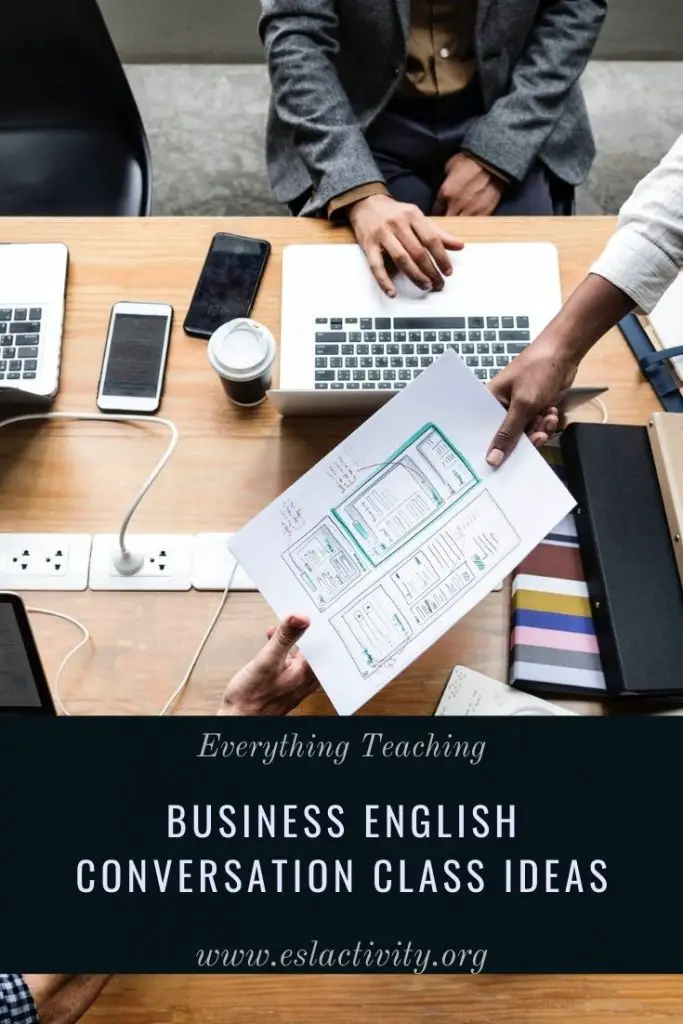
ESL business English
#23: Crossword Puzzle
It’s easy to make your own crossword puzzle to review any kind of vocabulary using the puzzle maker at Discovery.com (do a quick Google search). Input the questions and the answer and let the tool do the rest! These kinds of puzzles are ideal for a review before a midterm or final exam.
#24: Find the Word
Give students a worksheet with some definitions on them that you’ve covered in class the previous few weeks or months. Then, students can try to name the word without looking in their textbooks. If they get stuck, they can look in their books or ask a friend.
#25: Charades
I like to use charades to review just about anything! It works well for business English vocabulary as well. Put students into teams and then they have to take turns acting out a word or phrase. Their teammates have to guess what it is.
#26: 2 Truths and a Lie
Try out this fun icebreaker activity with your business English students:
Business English Discussion Questions
Here are some of the best business English conversation starters and discussion questions for students.
- If you had to start your own business this year, what kind of business would it be?
- What is the best business advice someone has ever given you?
- What’s a big mistake that you’ve made in business?
- Are you doing the career you thought you’d be doing in high school?
- If you had a million dollars to invest, how would you invest it?
- Can someone learn how to be a leader?
- What do you think about unpaid internships?
- Do friends make good business partners?
- Would you ever go into business with a family member?
Business English Lessons Plans
If you’re an English teacher, then you know how much time it can to use business ESL lessons that other teachers have put together. Here are some of the top options for teaching business English lessons plans:
Lingua House
One Stop English
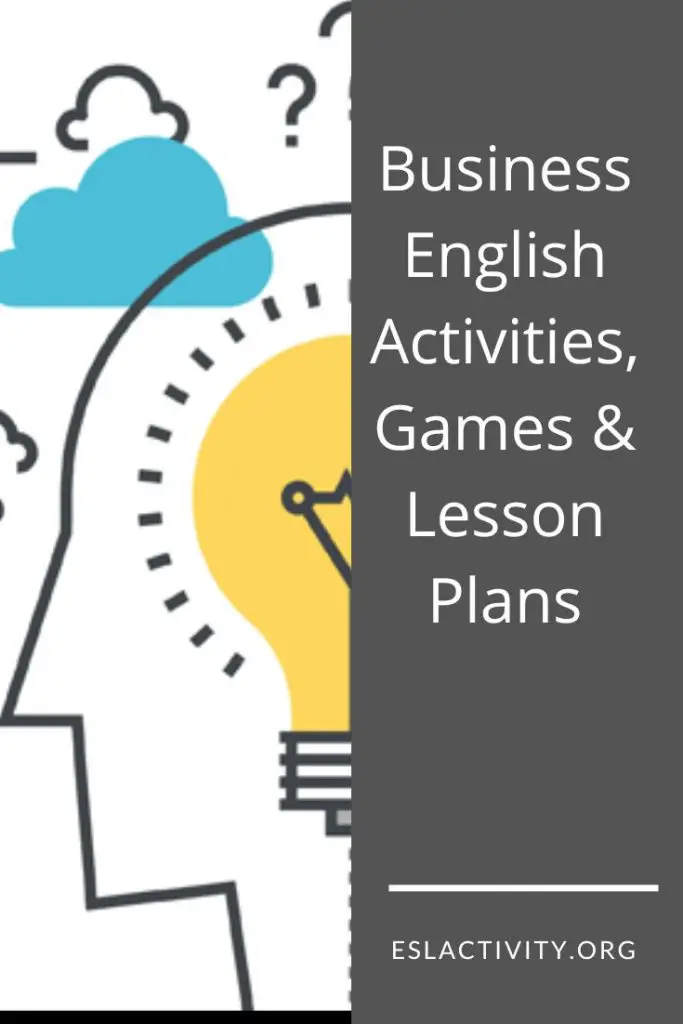
Business English Conversation Topics
Here are some of the most important business English conversation topics to cover in a course:
- Why some businesses succeed and why others fail
- Negotiations
- Job interviews
- Working abroad
- Dealing with a crisis
- Small talk over a meal
- Hiring somebody
- Firing somebody
- What makes a good leader
- Business presentations
- Dealing with a tough economic climate
- Managers and managing people
- Small businesses
- Business trips
- Competition
- Risk management
- Switching jobs
- Working as a team
- Sales strategies
- Promotional opportunities
- Customer service
- Contractors
Many of these topics such as risk management, negotiations and consulting are ideal for advanced business English lessons.
FAQs for Business English ESL
There are a number of common questions that people have. Here are the answers to some of the most popular ones.
What is one of the challenges of teaching Business English?
There are many challenges when teaching Business English, including a wide variety of levels of students within the same class. However, the biggest challenge may be external pressure from employers who expect a high level of proficiency in a short amount of time.
What is Business English course?
A business English course covers the basics of communicating in the business world, including phone calls and emails, presentations, negotiation, report writing, networking, and more.
Why do you study Business English?
The language of business around the world is often English. That’s why many people study Business English—to be able to communicate with colleagues and clients easily in a variety of situations.
How do I teach Business English to ESL?
There are a number of strategies that you can use to teach Business English to ESL/EFL students. Some of them include:
- Focusing on specific vocabulary that is required.
- Teaching functional language for negotiation, emails, etc.
- Using case studies to help students gain confidence.
- Teaching general communication skills such as eye contact and how to greet someone or finish a conversation.
- Maximize student talking time by having them work in small groups.
- Using a top-quality, industry-specific textbook.
- Understanding what the needs of your students are and tailoring lessons to that.
What are some of the most popular Business English textbooks?
Here are some of the Business English textbooks that we recommend:
- Market Leader
- Total Business
- Intelligent Business
- Business Builder
What is meant by business English?
What is meant by business English is that it’s the correspondence used by people in a business setting. It’s the language used for negotiations, job interviews, marketing strategies, talking about business deals and more.
Teaching Business English: Join the Conversation
Do you have any ideas for these kinds of classes that you’d like to share with us? Please leave a comment below and let us know what you think. We’d love to hear from you.
Also, be sure to give this article a share on Facebook, Pinterest, or Twitter. It’ll help other busy teachers, like yourself, find this useful resource.
Last update on 2022-07-17 / Affiliate links / Images from Amazon Product Advertising API
About Jackie
Jackie Bolen has been teaching English for more than 15 years to students in South Korea and Canada. She's taught all ages, levels and kinds of TEFL classes. She holds an MA degree, along with the Celta and Delta English teaching certifications.
Jackie is the author of more than 60 books for English teachers and English learners, including Business English Vocabulary Builder and 39 No-Prep/Low-Prep ESL Speaking Activities for Teenagers and Adults . She loves to share her ESL games, activities, teaching tips, and more with other teachers throughout the world.
You can find her on social media at: YouTube Facebook Pinterest TikTok LinkedIn Instagram
Top Selling ESL Activity Book

As an Amazon Associate, I earn from qualifying purchases.
More ESL Activities and Games
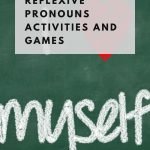
Reflexive Pronoun Activities, Games, Worksheets & Lesson Plans

Math Vocabulary Words in English | Mathematical Words List

English for Tourism: Learn Vocabulary for Working in Tourism Industry
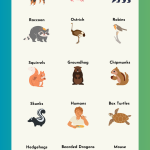
Omnivorous Animals List: Animals that Eat Both Plants & Meat
About, contact, privacy policy.
Best-selling author and English teacher Jackie Bolen has been talking ESL activities and games since 2015. The goal is to bring you the best ideas, lesson plans, and activity recommendations for your TEFL classes.
Get in touch: About + Contact
Privacy Policy and Terms of Use
Email: [email protected]
Address: 2436 Kelly Ave, Port Coquitlam, Canada

Business Presentation

Check out our useful expressions below to improve your business English skills.
Useful Expressions
- Nervous Mannerisms
- Presentation Tips
- Signposting
- Simple Presentations
- Speech Preparation
- The Language of Charts and Graphs
- Thinking Positively about Presentations
You are using an outdated browser. Please upgrade your browser .
Moscow International Business Center (Moscow City)
- Guide to Russia
What can you do at Moscow City?
- Dine in style: Moscow City is home to 100+ cafes and restaurants, including Europe’s highest restaurant and ice-cream shop
- See Moscow like never before: Ascend to one of Moscow City’s observation decks for an unparalleled panorama of Moscow
- Admire world-class architecture: Each of Moscow City’s skyscrapers has distinctive architecture and design
- Learn something new: Visit the Museum of High-Rise Architecture in Moscow or the Metro Museum
Moscow City is a multifunctional complex in the west of Moscow, which has come to represent the booming business of Russia’s capital. Its skyscrapers enrich Moscow’s skyline, contrasting the medieval cupolas and Stalinist high-rises. Visitors to Moscow City can enjoy entertainment high in the sky, as the complex is home not just to offices, but to restaurants, cinemas, viewing platforms, and museums.

Photo by Alex Zarubi on Unsplash
History of Moscow City
Moscow City was first conceived in 1991 by honoured Soviet architect Boris Tkhor, who proposed to construct a business center in Moscow. It would be complete with gleaming skyscrapers rivalling those of New York and London, to reflect the new life and growing ambitions of post-Soviet Russia.
The chosen site was a stone quarry and disused industrial zone in western Moscow, in between the Third Ring Road and Moskva River. Initially, the territory was divided into 20 sections arranged in a horseshoe shape around a central zone. The skyscrapers would increase in height as they spiralled around the central section, with shorter structures built on the waterfront to give the taller buildings behind a view of the river.
Architect Gennady Sirota, who contributed to iconic projects such as the Olympic Sports Complex on Prospekt Mira, was selected as the chief architect, and many other world-famous architects were attracted to Moscow to realise their visions in Moscow City.
What can you see and do at Moscow City?
Where Moscow’s cityscape was once dominated by Stalin’s Seven Sisters skyscrapers , this is no more. Moscow City is home to eight of Russia’s ten tallest buildings, six of which exceed 300 metres in height. More buildings are still under construction there today, including the One Tower (which will be Europe’s second-tallest building). Once completed, Moscow City will comprise more than 20 innovative structures.
Each of Moscow City’s skyscrapers was designed by its own architect, lending the cluster of skyscrapers a unique appearance. Aside from being a site of architectural wonder, Moscow City is a place for leisure and entertainment with over 100 cafes and restaurants, exhibition spaces, cinemas, viewing platforms, and more.
Photo by Nikita Karimov on Unsplash
Federation Tower
- East Tower: 374m, 97 floors; West Tower: 243m, 63 floors
- Completed in 2017
- Architects: Sergey Tchoban and Peter Schweger
The East Federation Tower is the tallest building in Moscow, and the second-tallest building in Europe after the Lakhta Centre in St Petersburg. Visitors can enjoy a luxurious meal of seafood, truffles or steak at restaurant ‘Sixty’ on the 62nd floor of the West Tower, or visit Europe’s highest observation deck, ‘Panorama 360’, on the 89th floor of the East Tower.
Did you know? The ice cream and chocolate shop on the 360 observation deck are the highest in the world!
- South Tower: 354m, 85 floors; North Tower: 254m, 49 floors
- Completed in 2015
- Architect: Skidmore, Owings & Merrill LLP
The South OKO Tower is the third-tallest building in Russia and Europe. Here, you can visit ‘Ruski’ to dine on hearty Russian cuisine cooked on a real Russian stove, and have a drink in the ice bar. Alternatively, visit restaurant, nightclub and performance space ‘Birds’; the restaurant is the highest in Europe, situated on the 86th floor roof terrace alongside an observation deck. The OKO Towers are also home to karaoke club ‘City Voice’.
Did you know? Underneath OKO Towers is the largest underground parking in Europe, with 16 levels and 3,400 parking spaces.
Mercury Tower
- 339m tall, 75 floors
- Architects : Mikhail Posokhin, Frank Williams, Gennady Sirota
Another multifunctional skyscraper, which was designed as the first truly ‘green’ building in Moscow. The Mercury Tower has a distinct geometric shape and copper-coloured glazing, and was the tallest building in Europe upon completion. Visit ‘More i myaso’ (Sea and meat) on the first floor of the tower to enjoy European and Mediterranean cuisine whilst surrounded by greenery. On the 2nd and 40th floors a modern art gallery, the ‘ILONA-K artspace’, has just opened.
City of Capitals
- Moscow Tower: 302m, 76 floors; St Petersburg Tower: 257m, 65 floors
- Completed in 2009
- Architect: Bureau NBBJ
The unique geometric design of the City of Capitals towers resembles stacks of rotating blocks, and is rooted in Constructivism of the early Soviet period (many Soviet Constructivist buildings can be found in Moscow). Visitors to the Moscow Tower can enjoy a range of cuisines – traditional Italian dishes on the summer terrace of ‘Tutto Bene’, Panasian cuisine in the tropical luxury of the ‘Bamboo Bar’ on the 1st floor’, and poke or smoothie bowls at ‘Soul in the Bowl’ cafe on the 80th floor.
Tower on the Embankment
- Tower A: 84m; Tower B:127m; Tower C: 268m, 61 floors
- Completed in 2007
- Architects: Vehbi Inan and Olcay Erturk
After completion, the Tower on the Embankment was the tallest building in Europe, and is now the 13th tallest. It houses the headquarters of several large Russian and international companies, including IBM and KPMG. There are two cafes located on the 1st floor of Tower C – self-service café ‘Obed Bufet’ (Lunch Buffet) and Bakery Chain ‘Khleb Nasushchny’ (Daily Bread).
Evolution Tower
- 255m tall, 54 floors
- Architects: Philip Nikandrov and RMJM Scotland Ltd
Evolution is Moscow City’s most recognisable tower, and the 11th tallest building in Russia. Its façade is a true architectural marvel, comprising continuous strips of curved glazing spiralling high into the sky. According to the architect, Philip Nikandrov, the spiral shape of the tower honours centuries of architectural design in Russia, from the onion domes of St Basil's Cathedral to Vladimir Shukhov’s Tatlin Tower, a masterpiece of Constructivist design. Outside the Evolution tower is a landscaped terrace and pedestrian zone descending to the Presnenskaya Embankment, which was also designed by Nikandrov.
Did you know? Moscow’s largest wedding palace was supposed to be built on the site of the Evolution tower, though the project was abandoned.
- 239m tall, 60 floors
- Completed in 2011
Imperia’s interesting design has a curved roof and an arched glass façade. Inside the tower are various cafes including ‘City Friends’ for all-day breakfasts and light lunches, ‘Mama in the City’ for simple meals of Russian cuisine, and ‘abc kitchen’ for European and Indian-inspired dishes. Alternatively, visit ‘High Bar’ on the 56th floor for cocktails with a view. In Imperia you’ll also find the Museum of High-Rise Construction in Moscow (suitably located on the 56th floor), and the Camera Immersive Theatre.
Did you know? Inside Vystavochnaya metro station is the Metro Museum , dedicated to the history of the beautiful Moscow Metro!
- 130m tall, 26 floors
- Completed in 2001
- Architect: Boris Tkhor
Tower 2000 was Moscow City’s first tower. It stands on the opposite bank of the Moskva River, and houses a viewing platform from which visitors can admire an unparalleled panorama of Moscow City. The Bagration Bridge reaches across the river from the tower to Moscow City, and underneath are piers from where you can take boat trips.
Photo by Alexander Popov on Unsplash
Afimall is Moscow’s largest entertainment and shopping complex, home to 450 shops, cafes and restaurants, a cinema, and a virtual-reality game park. The shopping centre is located in the central section of Moscow City, and a cinema and concert hall are currently under construction there.
What’s nearby?
Sechenov Botanical Gardens: The botanical gardens of the First Moscow State Medical University was created for students’ training and research in 1946. Today it is open for free visits, and is home to a large arboretum.
Park Krasnaya Presnya: This park belonged to the Studenets estate of the Gagarin princes. It is a monument of 18th and 19th century landscaping, with Dutch ponds, ornate bridges, and tree-lined alleys. There are also sports facilities, sports equipment rental, and cafes.

Photo by Akkit on Wikipedia
Essential information for visitors
Website: https://www.citymoscow.ru/
Email: [email protected]
Phone: +7 (495) 730-23-33
Nearest metro: Mezhdunarodnaya (closest to the skyscrapers), Delovoy Tsentr (underneath Afimall), Vystavochnaya (closest to Expocentre)
Related Tours

Moscow - St. Petersburg 3-star cruise by Vodohod
This is our most popular cruise covering Moscow and St. Petersburg and all of the significant towns between these 2 cities. Besides the Two Capitals, you will visit the ancient towns of Uglich, Yaroslavl and Goritsy, the island of Kizhi, and Mandrogui village.
Cruise Ship

Two Capitals and the Golden Ring
This tour covers the best sights of Moscow and St. Petersburg along with a trip to the Golden Ring - a group of medieval towns to the northeast of Moscow. Ancient Kremlins, onion-shaped domes and wooden architecture is just a small part of what awaits you on this amazing tour.
Accommodation
PRIVATE TOUR

Classic Moscow
This is our most popular Moscow tour that includes all the most prominent sights. You will become acquainted with ancient Russia in the Kremlin, admire Russian art in the Tretyakov Gallery, listen to street musicians as you stroll along the Old Arbat street, and learn about Soviet times on the Moscow Metro tour.
Our travel brands include

Express to Russia
Join us on Facebook
We invite you to become a fan of our company on Facebook and read Russian news and travel stories. To become a fan, click here .
Join our own Russian Travel, Culture and Literature Club on Facebook. The club was created to be a place for everyone with an interest in Russia to get to know each other and share experiences, stories, pictures and advice. To join our club, please follow this link .
We use cookies to improve your experience on our Website, and to facilitate providing you with services available through our Website. To opt out of non-essential cookies, please click here . By continuing to use our Website, you accept our use of cookies, the terms of our Privacy Policy and Terms of Service . I agree
- Attractions
- Photos & Videos
- Privacy policy
- Terms & Conditions
Wedding Palace

The foundations for Wedding Palace was executed by BAUER Technologie the Russian branch company of BAUER Spezialtiefbau GmbH. Scope of works was 163 pieces of D1500mm piles, each 30m deep. Cementation under each pile, and two Osterberg cell tests. The foundation was successfully completed between July-December 2008. For more information visit: BAUER Technologie

Imperia Tower is a multipurpose complex located on plot 4 of the Moscow International Business Center. It will consist of 2 buildings, the mixed-use Building A and the water park entertainment complex in Building B.

Building A, totaling 60 floors, will incorporate over 70,110 square meters (750,000 sq ft) of office space, 45,000 m2 (480,000 sq ft) of apartments, a 280 room hotel (30,000 m2/320,000 sq ft), and assorted retail outlets.

Building B will incorporate the water park and will be a focus of entertainment for the MIBC Complex. It will also house a shopping mall, restaurants and cafés, and will be open year-round.
Eurasia Tower

The Eurasia Tower, located on plot 12, is an office/recreational space with a total area of 207542 square meters. It will be situated on a three-tier podium in which will be placed a fitness center, entertainment, restaurants, and shops. Other areas will be distributed as follows: 106 231 square meters will be reserved for office space, and residential apartments will occupy 21185 square meters. On the bottom, there will be parking for more than 1000 cars. The external design of the building is a combination of classical and modernist style. On the outside of the building, a scenic elevator will run up and down for views of the entire city.
- Number of Floors: 67
- Height: 305 meters
- Total Investment: $250 million
- Total Area: 207,542 square meters
- The area of office premises: 106 231 m
- The area of premises: 21 185 m
- Parking capacity: 1000 places
- Developer: Mos City Group
- Eurasia Tower site
- Official site TechInvest
Federation Tower

Federation Tower will be Europe's first supertall tower, and the second tallest tower in Europe after Russia Tower.
- Tower A: 93 floors - 360 metres tall
- Tower B: 62 floors - 243 metres tall
- Tower C: Spire - 506 metres tall
The unique construction combines architectural elegance, comfort and ergonomics. Upon completion, this will be the tallest building in Europe, at the height of 506 metres.
Office complex "Federation" is on plot 13 MIBC "Moscow-city". The structure represents a design of two tri-hedral towers with height of 360 and 243 metres above the ground, located on a common base of 10 floors. Between them the spike, with a height of 506 metres. In the towers a restaurant is planned, along with office psuites and residential apartments divided by technical floors. In the spike elevators with panoramic views and an evacuation stairway will be placed. In the base of the towers a full complex of retail and household services is planned. The underground part includes parking places, technical premises, and the walkway connecting the complex with the central part of a Business Centre, northern departure and a complex 12 site.
- Developer: ZAO Mirax-City, Russia
- Employer: ZAO Mirax-City, Russia
- Architect: Prof. P. Schweger and S. Tchoban (Germany)
- Total Investment: $500 million
- Total Area: 425,000 square metres;
- Total area of a plot: 1,07 hectares
- Height: over 506 metres
- Construction began: 2004
- Official site
Mercury City Tower

Multipurpose building with housing and open space, premises of trading and cultural appointment «Mercury City Tower» on plot 14 MIBC "Moscow-city". The structure's height is 322 metres (with a spike bringing it to 380) above the surface of the ground, with five underground floors. In a building office premises, apartments, the trading areas, and also restaurants will be located. The underground part, consisting of 5 floors, includes parking places, technical, and retail space.
- Architect: M.M. Posohin, Frank Williams (USA), G.L. Sirota
- Total area of a plot: 0,4975 Hectares
- Total Area: 158,000 square metres;
- Height: 380 metres
- Amount of floors: 70
- The area of offices: 86 000 square metres
- The area of Apartments: 24 000 square metres
- The area of Fitness centre: 5 000 square metres
- The area of Restaurants: 3 500 square metres
- Trading premises: 6 200 square metres
- Those a premise: 16 900 square metres
- Parking place: 18 000 square metres
Russia Tower

Construction began in September, 2007, and is planned to be completed in 2011. Upon reaching its final height of 612.2 metres (2,009 ft), it will be the tallest building in Europe and the second tallest in the world.
The total area of the structure will cover 520,000 m² (5,597,233.4 sq ft), of which 38% (200,000 m² (2,152,782.1 sq ft)) will be located underground. The tower will contain 118 floors, 101 lifts, and underground parking to accommodate 3,680 cars. Commercial retail shops will be located at the base of the building. The maximum capacity of the building is projected to be around 30,000.

The first ten floors will be occupied with the common part in which the parking will be placed. In the bottom part of a tower of office premises, a hotel will be located, the top floors will be occupied by apartments. In a business part of the project is expected to house a large congress centre, hotel, an entertainment zone, and a casino and park of attractions. Construction is planned on a plots 17-18 MIBC "Moscow-City". The developer of the project is the Moscow company (MDC), in cooperation with the city government and CT-Towers is the affiliated structure STT Group created for realization of projects in MIBC "Moscow-City". The final project of a tower has been presented by architect Norman Foster on March 15th, 2006 at exhibition MIPIM-2006 in Cannes. After completion, Russia Tower will become the tallest tower in Europe.
- Total area of a plot: 2,19 hectares
- Total Area: 520,800 square metres
- Amount of floors: 118
- Height: 612 m
- Cost of the project: $1,5-1,7 billion
- Spaciousness of the built in parking: 3680 place
- Amount of lifts: 101
- Construction began: on September, 18th, 2007
- Construction completed: 2012
- The status of the project is currently preparation for construction
- Russia Tower forum-site
External links
- All about Moscow-City
- Moscow-City English-Speaking Forum
- Skyscrapercity Forum Thread
- http://www.moscowcity.ru/
- http://www.citynext.ru/
- http://www.a-s-r.ru/tabid/247/Default.aspx
- http://www.icube3d.ru/portfolio/vis/ani/mmdc/

+7 495 664-89-89
novotel-moscow-city.com
Novotel Moscow City on Foursquare
Moscow International Business Centre on Facebook
Hotels nearby
starting $256
starting $293
starting $1950
starting $755
starting $102
starting $10
Similar tourist attractions
Ministry of Foreign Affairs of Russia is the central government
The Aon Center (200 East Randolph Street, formerly Amoco Building) is
Almas Tower (Arabic: برج الماس Diamond Tower) is a supertall
One Beacon Court (also called the Bloomberg Tower), is a skyscraper on
7 World Trade Center is a building in New York City located across
- Change your filters
- Zoom out on the map
Registration
PowerPoint Map Templates – International Cities
Munich - city map powerpoint template.
Map set contains Bogenhausen, Grünwald, Westend, Neuhausen, Schwabing, Isarauen etc.
Cologne - Citymap PowerPoint Template
Map set consists out of Rodenkirchen, Lindenthal, Ehrenfeld and others.
Hamburg - Citymap PowerPoint Template
Map includes states such as Altona, Hamburg Mitte, Eimsbüttel, Hamburg-Nord, Wandsbek, Bergedorf, Harburg.
Moscow - City Map PowerPoint Template
Easily editable Moscow city map includes Basmanny, Koptevo, Khamovniki, Severny and others.
Frankfurt - City Map PowerPoint Template
Frankfurt city map (Bockenheim, Sachsenhausen, Nordend-West, Bornheim and others).
Vienna - City Map PowerPoint Template
Vienna city map (including Wieden,Innere Stadt etc.) to easily name, highlight and pin locations.
Berlin - City Map PowerPoint Template
Berlin city map template containing Spandau, Friedrichshain, Pankow, Treptow and more.
New York City - Citymap PowerPoint Template
New York City map template comprises Brooklyn, Manhattan, Queens and more.
Tokyo - City Map PowerPoint Template
Adjustable Tokyo city map to name, pin, and highlight locations (Chiyoda,Adachi, Arakawa and other regions).
Paris - City Map PowerPoint Template
Editable Paris city maps to highlight, name and pin locations (incl. Champs-Élysées, Montparnasse and more).
London - City Map PowerPoint Template
London city map includes Greenwich, London City, Westminster and more.
Los Angeles - City Map PowerPoint Template
Los Angeles city map template incl. every district (Beverly Hills, Santa Monica, Brentwood, Westwood and others).
Chicago - City Map PowerPoint Template
Chicago city map template incl. Central Chicago, South Side, Southwest Side, Far Southeast Side and others.
Corporate Services
We’ll optimize your existing PowerPoint presentation and create slides in your corporate design.
New PowerPoint Templates
We are continually bringing you new PowerPoint templates on current business topics and in modern designs.
- Business & Finance
- Real Estate
- Transportation
- Tourism & Hotels
- Conferences
Moscow To Increase Tourism Amongst UAE Citizens
The Moscow City Tourism Committee concluded a business mission in Dubai on February 7th to discuss primary tourism objectives and development between both countries, positioning Moscow as a top tourist destination.
The delegation from the Moscow City Tourism Committee consisted of representatives from major tour operators and the hospitality industry. They met with 113 members of local companies, government agencies, and other interested organizations to explore potential cooperation opportunities. Within the framework of the business mission, approximately 2,000 cooperation negotiations were concluded.
“We are committed to maintaining this relationship as the Gulf countries remain one of the most promising markets for inbound tourism to Moscow. Business guests enjoy experiencing the high level of hospitality and services in Moscow, as well as the city’s carefully preserved historical heritage. We hope to see more of these business visitors return with their families to enjoy the leisure and beauty of the Russian capital,” said Mr. Bulat Nurmukhanov, Head of the International Cooperation Division of the Moscow City Tourism Committee.
Bulat Nurmukhanov also noted that this business mission to the UAE signifies Moscow’s commitment to strengthening its relationship with Middle Eastern countries and promoting tourism potential between both regions. The delegation is optimistic about the opportunities that may arise from these discussions and looks forward to fostering long-term partnerships with their counterparts in the UAE.
During the meeting, a presentation showcasing Moscow’s tourism potential was conducted, highlighting the diverse array of activities available in the city. It was noted that group and family tourism were among the fast-growing and popular choices for UAE residents.
Earlier in 2023, the Moscow City Tourism Committee organized business missions to the Kingdom of Saudi Arabia, Qatar, and the Kingdom of Bahrain, resulting in thousands of negotiations with partners from Middle Eastern countries.
These events aimed to develop tourism cooperation between the Moscow City Tourism Committee and the Gulf Countries, as well as strengthen business relations in the tourism industry.

IMAGES
VIDEO
COMMENTS
LESSON OVERVIEW. In this lesson about business presentations in English, students discuss presentation structures in depth, watch a video with tips on giving presentations, and learn useful words and phrases related to the topic.. The lesson is the first of the three-part series of lessons about delivering presentations.
Students briefly discuss their own experiences of presentations before identifying types of diagrams often used in presentations and their functions. They listen to a business presentation and identify and practise a range of functional language for structuring presentations. The lesson includes vocabulary development and a presentation ...
This Business skills lesson plan by Tim Bowen presents common features of presentations and practises useful language for putting together and giving presentations. Lesson length: 60-75 mins. Materials: Worksheets 1-5. Subsidiary aims: Listening (or reading) for specific information, discussion of what makes a good presentation.
Most audiences will expect you to give your presentation using formal Business English. Don't make the mistake of confusing Business English with business jargon. Successful Business English uses language that is simple, direct, professional and easy to understand. Business jargon on the other hand, relies on obscure phrases, clichés, and ...
If you need more specific vocabulary, like for a presentation to the board, your manager, or a client on their finances, check out our blog post on the most common English for accounting vocabulary. 4. Prepare some visual aids. These days, most people use a slide deck when presenting business ideas.
ACTIVATE - Business English Lesson Plan. Aim: Students will create a presentation with the assistance of ICT tools (PowerPoint/Camtasia) to sell a product to their classmates using appropriate vocabulary and body language. Techniques: collaborative writing and discussion. Skills: Speaking, listening, reading and writing.
There are 4 modules in this course. This course teaches you language and techniques that will help you make effective presentations in English. The final task is to develop a well-organized, persuasive presentation using charts and graphs that sells your city as a venue. The course focuses on students who have an intermediate level of English ...
If you follow each of these steps before presentation day, you will be in good shape.Key vocabulary and phrases - Like any area of English, preparing some key phrases and vocabulary for presentations will help you feel more confident and comfortable when it comes to presenting. We list a number of different key phrases for different areas of ...
Step 1: The Foundation to Your Business Presentation - Goal, Audience, Past Experience. This first step is essential for a successful business presentation, as it sets the foundation for the rest of your preparation. Ask yourself what exactly it is that you want to achieve with this presentation.
Intermediate (B1-B2) This lesson plan is a great way to develop students' ability to talk about people's personality and character traits at work. The worksheet presents a variety of adjectives for describing qualities and flaws, as well as additional expressions for describing typical office personalities. Lesson 10.
This lesson looks at the language of talking about graphs and charts in presentations. Students will read a presentation speech and listen to a presentation while completing a graph. Exercises focus on reading and listening skills, related vocabulary and offer the opportunity for students to discuss questions on the topic. by Joe Wilson.
They want to practice situations taken from their professional environment, and discuss real-life Business English topics. Some are: making phone calls, being able to hold and carry on conversations, speaking with colleagues, preparing and giving presentations, or negotiations.
Check out the top picks for business English ESL activities, along with lesson plans for teaching Business English for beginner-advanced. ESL Activities. ESL Games, Activities, Lesson Plans, Jobs & More ... Offering Help ESL Lesson Plan. #6: Presentations and Public Speaking for Business English Lessons.
This is a lesson plan for C1-C2 students designed to develop their understanding of vocabulary to describe gadgets, apps and pieces of software. Candidates are often required to describe such things in writing tasks in the main suite of Cambridge exams. This lesson plan may also be useful for business English classes.
Simple Presentations. Speech Preparation. The Language of Charts and Graphs. Thinking Positively about Presentations.
Providing an outline at the beginning of a business presentation can help set the stage for effective communication and informative delivery. 19. Here is an overview of what will be covered. 20. Focusing on the main points-. 21. First of all-. 22. I'm going to cover three main points today.
A selection of English ESL business english ppt slides. Log in / Register. Worksheets. Powerpoints. Video Lessons. Search. Filters. ... Business English Spe. This PPT was created. 844 uses. sirhajwan87. Business English (Ex. This slideshow conta. 630 uses. Yaser. key terms in busines. this slide show give.
A selection of English ESL business ppt slides. Log in / Register. Worksheets. Powerpoints. Video Lessons. Search. Filters. Browse Topics: Grammar Topics General Topics. ... Business English Tip. Italian and English . 2798 uses. riket. Teaching Business En. Pointers for ESL tea. 1514 uses. TeachTEFL. Money and Business. This is a conversati ...
255m tall, 54 floors. Completed in 2015. Architects: Philip Nikandrov and RMJM Scotland Ltd. Evolution is Moscow City's most recognisable tower, and the 11th tallest building in Russia. Its façade is a true architectural marvel, comprising continuous strips of curved glazing spiralling high into the sky.
The upper floors of the base structure will contain shops, a fitness center, presentation halls, and restaurants. Москва-Сити / Moscow-City — ruscow @ Flickr To create the concept for the offices in the City of Capitals, other business complexes and business centers from other parts of the world have been studied.
Chicago city map template incl. Central Chicago, South Side, Southwest Side, Far Southeast Side and others. $19.00*. We'll optimize your existing PowerPoint presentation and create slides in your corporate design. Choose from our map templates of international cities including Berlin, Frankfurt, Hamburg, New York City, LA, Chicago, Moscow ...
The Moscow City Tourism Committee concluded a business mission in Dubai on February 7th to discuss primary tourism objectives and development between both countries, positioning Moscow as a top tourist destination. ... During the meeting, a presentation showcasing Moscow's tourism potential was conducted, highlighting the diverse array of ...